Two Weeks in Italy: A Complete Guide for First Timers
There’s a good reason why Italy tops the bucket list of countless travelers. It has a unique historical significance (even though Italy itself is actually one of the youngest countries in Europe) thanks to the Roman Empire’s escapades, it has a famous food culture (not to mention the wine), and it has gorgeous scenery.
Italy has spent hundreds of years building its brand which has millions of people dreaming of visiting Italy.
But as we’ve learned over the course of our time in Italy over the past two years (almost two months in total), boiling the entirety of Italy down to just a handful of things it’s famous for means that you’re missing the things that really make Italy special.
Coming from an American perspective, we have a very specific view of what it means to be “Italian” that involves numerous stereotypes including some combination of chicken parmigiana, garlic bread, and talking with your hands (in our experience, only one of those is genuinely found in Italy – which one is it?).
However, after several trips where we’ve been able to go a level deeper than you usually do on that first trip, we’ve come to realize something important.
Italy is a surprisingly diverse country.
Not necessarily in terms of race or ethnicity, which is how the word “diversity” often gets translated, but in terms of regional differences that have been formed over thousands of years.
The regional differences in culture, dialect, and cuisine that come from centuries spent as independent (and often warring) city states are what we love about Italy, and that diversity is what makes Italy a fascinating place to visit.
As you move between regions, you’ll notice that the food and wine menus change drastically, as do the accents and cultural norms.
With so much to learn, see, eat, and drink in Italy, how do you even go about planning a two week trip to Italy?
In this guide, we’re going to go through what is, in our minds at least, a perfect 14 day Italy itinerary.
It covers Italy’s major cities – Rome, Florence, and Venice – along with some time spent in less heralded places like Bologna that most tourists miss, but we believe is well worth a stop.
This guide is geared towards first-timers who want to see those main cities, but we also have an entire section below the main itinerary full of ideas on how to modify it, which you might find useful if you’ve done the whole Venice thing before and are looking for something new.
Either way, grab a cup of coffee (or a spritz?) and buckle in for a long one – here’s exactly (and we mean that) how we’d spend two weeks in Italy.
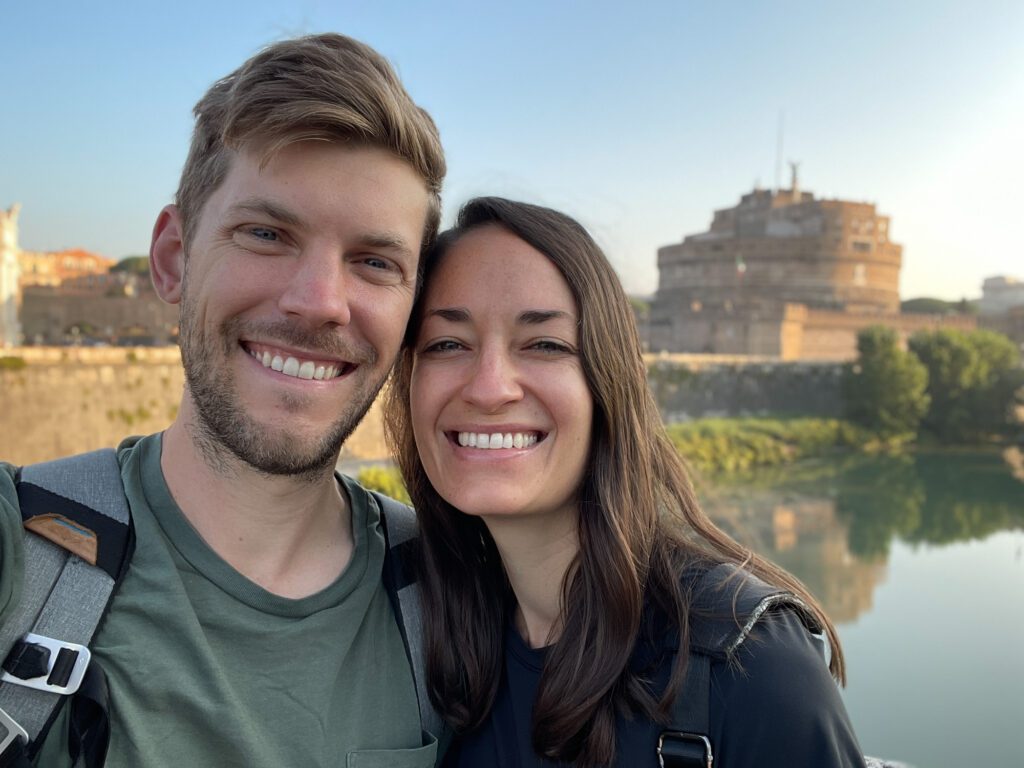
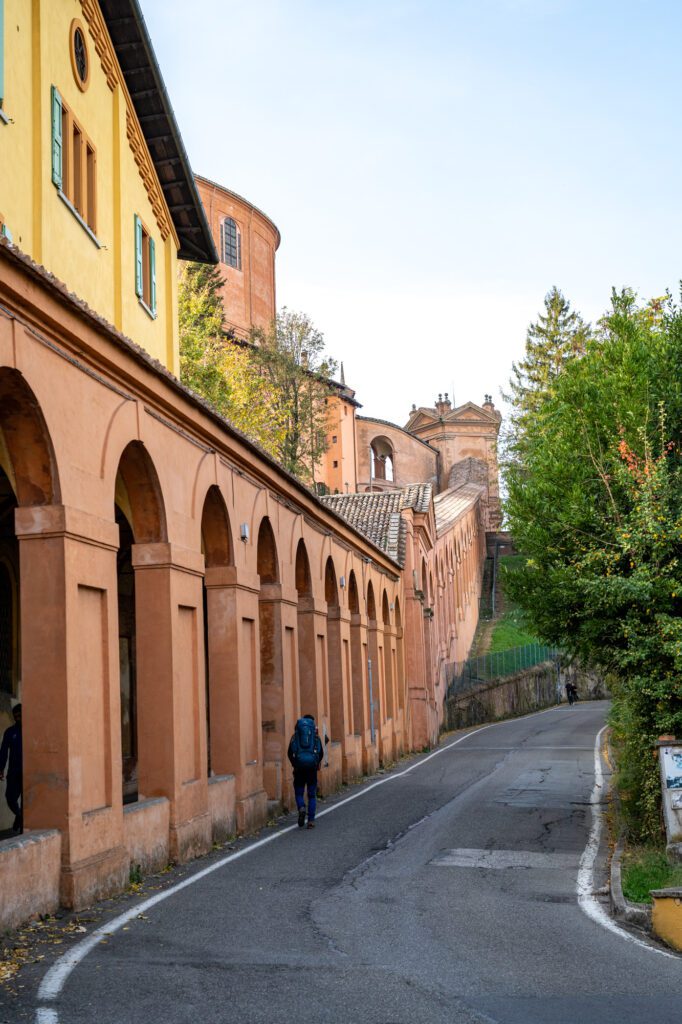
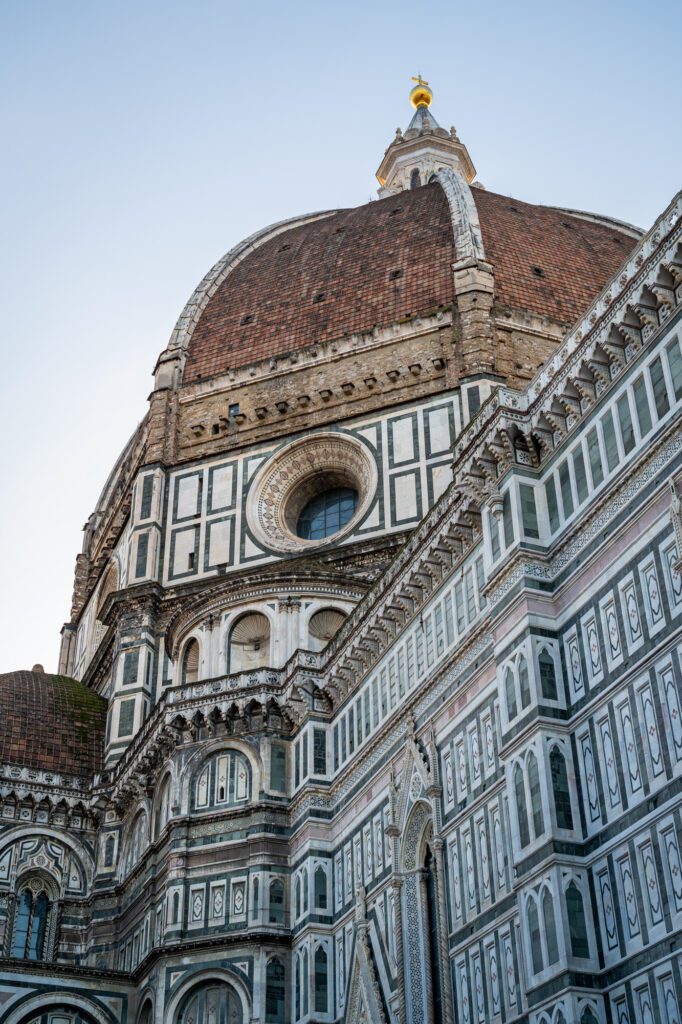
Disclaimer: Some of the links in this post, like hotel links, are affiliate links, meaning at no additional cost to you, we make a little bit of money if you click through and book. That being said, we would never recommend something to you that we don’t stand behind 100%.
Is 14 Days Enough Time in Italy?
In short, no. Definitely not. However, we do think it’s a good amount of time to see a chunk of the country that will give you a nice overview and help you decide where you want to dive deeper on your next trip.
In this itinerary – which is primarily designed for first timers – we’re going to cover both the main cities (Rome, Florence, and Venice) and some of our favorite places that don’t usually make the list (Bologna and Verona).
P.S. If you have a shorter trip, make sure to check out our guide to 10 days in Italy, which focuses on Rome, Florence (and the surrounding area), and Venice, or our guide to spending a week in Italy, which has five ideas for a week in Italy that you can mix and match to build your own itinerary.
There are two places that you won’t find in this itinerary for various reasons.
First is southern Italy – specifically Napoli, Pompeii, and the Amalfi Coast.
The reason is not that they aren’t beautiful or worth seeing, but that we think your time is better spent in northern Italy, which is our favorite part of the country.
Getting between Napoli and northern Italy is going to take a lot of time that would be better spent exploring!
The second place is the Cinque Terre, and it’s for a similar reason. The Cinque Terre is gorgeous. But it’s not particularly easy to get to.
You’ll need to make multiple connections from Florence, and it’s going to take about three hours each way.
If you do want to add the Cinque Terre, you’ll need at least two full days. We have some ideas on how to add it below the main itinerary.
If you’re interested in visiting Cinque Terre, make sure to read our guides for Cinque Terre.
Where to Fly In and Out Of?
If you follow the itinerary below as written, which takes you on a tour-de-Italy from Rome to Venice, you’ll want to fly into Rome–Fiumicino International Airport (FCO) and out of Venice Marco Polo Airport (VCE).
An alternative would be to fly out of Milan (either LIN or MXP – we like LIN better because it’s closer to the city and a newer airport), which generally has more flight options than Venice, but it requires an extra day or two and a train.
Getting Around Italy
The best way to get around Italy is by train. At least for your purposes on the itinerary below It’s going to be cheaper, faster (once you include travel time and security at the airport), and better for the planet than hopping on a short flight.
There are a few things you should know about trains in Italy before we get any further.
First, there are (essentially) two types of trains in Italy – high speed and regional – and they operate differently.
High speed trains are more expensive, significantly faster, and less flexible. To save time since you’ve only got a limited amount of it in Italy, you’ll want to take the high speed trains between cities.
You’ll want to book your ticket as far in advance as possible, which usually will save you some money, but will be less flexible. If you want the flexibility, you’ll have to be prepared to pay a little extra.
Regional trains are slower, cheaper, and more flexible. They’re usually for connecting nearby smaller cities to each other (for example, there’s a regional train between Florence and Pisa).
You can buy these tickets when you arrive at the station, and they’re more flexible. You need to make sure you validate them before boarding.
The best way to book train tickets in Italy is directly through Trenitalia, the company that runs most of the trains in Italy. The only downside is that you’ll need to know the name of the station you want to travel to in Italian.
We’d take high speed trains between Rome and Florence, Florence and Bologna, Bologna and Verona, and Verona and Venice. For day trips from Florence and Bologna, regional trains will do.
The Itinerary / Route
And now, the itinerary itself.
One quick note: In general, when you’re moving between cities, we’d recommend taking an afternoon train, which will give you some extra time to explore the city you’re leaving in the morning before heading to the train station.
Here’s how we would plan a trip to see the best of Italy over the course of two weeks, starting in Rome and ending in Venice:
- Day 1: Arrive in Rome
- Day 2: Rome
- Day 3: Rome
- Day 4: Rome + Train to Florence
- Day 5: Florence
- Day 6: Florence
- Day 7: Florence Day Trip
- Day 8: Train to Bologna
- Day 9: Bologna
- Day 10: Day Trip to Verona
- Day 11: Train to Venice
- Day 12: Venice
- Day 13: Venice
- Day 14: Venice + Fly Home
You’ll notice a couple of different things about the way we’ve structured this itinerary.
First, we’re big fans of spending at least 2-3 days in big cities to avoid feeling like you’re rushing around from sight to sight. That will give you some time to do some exploring to find a new favorite neighborhood, coffee shop, wine bar, or restaurant.
Second, we hate packing and moving accommodations. It sucks. Which is the reason we’re recommending you stay in a place like Florence or Bologna and use it as a home base for exploring the surrounding area.
Third, we’ve included a significant chunk of time in Bologna. Which is our favorite city in Italy not named Rome or Florence (Lucca and Verona are also in the running).
Here’s why: Bologna is the capital of the best food region in Italy, home to the production of delicious things like Parmesan-Reggiano cheese (we LOVED touring a small producer of Parmigiano-Reggiano with Claudio on this tour), prosciutto di Parma, mortadella, balsamic vinegar, Lambrusco (a sparkling red wine), tortellini, ragu, and plenty more.
Not only is the food incredible, but the city – which feels noticeably younger and less “touristy” than most of the cities here – is a nice change of pace from places like Rome, Florence, and Venice.
Bologna also makes an excellent home base for day trips because it is so well connected.
Whatever you do, we’d implore you NOT to cut Bologna. It’s an amazing city, and you won’t regret spending a day or two there.
Fourth, it might seem like a lot of time in Venice at the end. However, it’s really only two and a half days if you take a midday train there, and have an early flight home.
If you have a full 14 days (you’re flying out on day 15, for example), we’d add an extra day either in Florence to do another day trip, or in Rome.
2 Weeks in Italy: A Perfect 14 Day Italy Itinerary for First Timers
And now, on to the detailed itinerary.
Our intention here is to give you the information we think you need to know to plan an amazing trip to Italy.
We’ll go a little deeper than a short description of each place, giving you some of our favorite things to do, see, eat, and drink that come from our own experiences exploring Italy (and, equally crucially, what not to do – looking at you, Juliet’s House in Verona!).
We believe those details – like specific wine bars, tours, and coffee shops we loved – are the difference between a good trip and an incredible trip, and hope you’ll find a few places that you wouldn’t have necessarily found on your own.
The other intention here is to not just give you the same old itinerary that you’ll see in every guidebook.
Of course, we’re going to include Rome, Florence, and Venice, because those are places that are absolutely worth seeing on your first trip to Italy.
However, we’re also going to include some of our favorite places (like Bologna) that don’t usually make the cut. Rick Steves (who Matt loves – he’s from Seattle too!) doesn’t even include Bologna in his Italy guidebook! What a miss.
Rome: Days 1-3
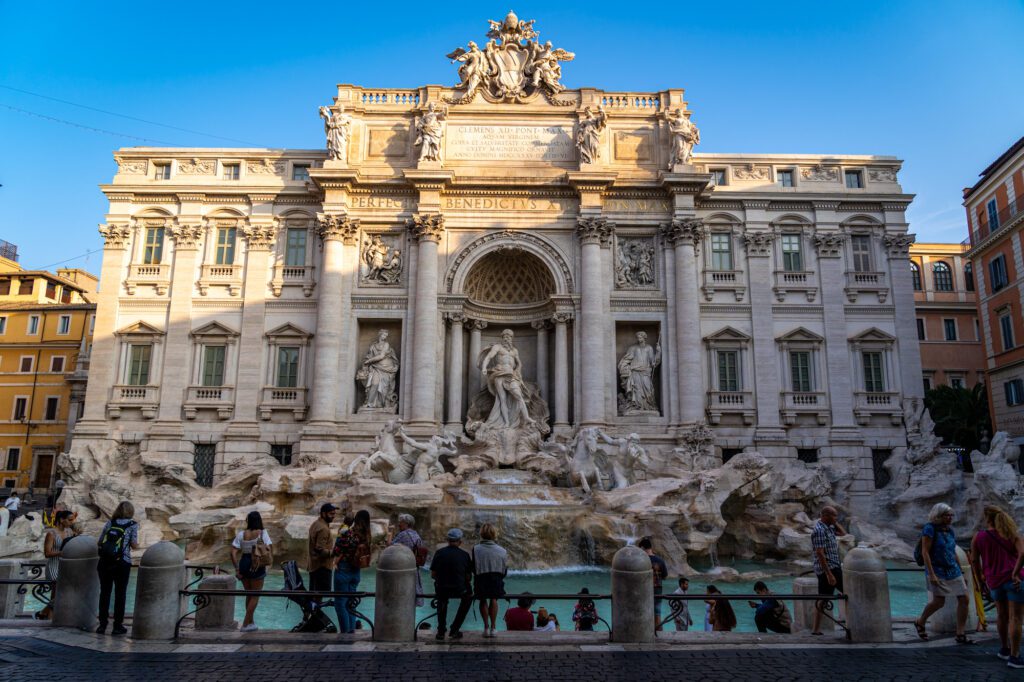
I mean, if you’ve never been to Rome before, you’re in for a treat. Rome is one of our favorite cities in Europe, and there’s something special about walking past architecture from over a thousand years ago on your way to a hip natural wine bar in the evening.
While Rome is famous for its historical sights, it’s also a great city for food and drinks (as we’ll cover below) and as I’m sitting here writing this, I literally made a Roman pasta dish (amatriciana) for dinner last night.
We’d recommend three days in Rome, at a minimum, which will allow you enough time to see both of the main attractions, dive into the history of Italy’s capital city, and also indulge in some of Rome’s great food and drinks.
What to Do in Rome
Look, there are two main attractions in Rome that, if it’s your first trip, you probably shouldn’t miss.
They are, of course, the Vatican and the Colosseum and Roman Forum. They’re popular and “touristy,” but being touristy doesn’t necessarily mean it’s not worth doing.
However, you should absolutely split them up and avoid doing them on the same day. It will simply be too much information if you try to knock them both out on the same day, and you will be exhausted, which means you won’t get the most out of them.
Do them on different days. Trust us.
Let’s talk about those two first. However, this is going to be relatively brief.
For a more in-depth version of how we think you should experience them, head over to our guides to the best things to do in Rome, our guide to planning your Rome itinerary, and our review of the Colosseum and Forum tour we did (and, spoiler alert, loved).
The Colosseum and Roman Forum are perhaps the best example in Rome of the grandeur that the Roman Empire was able to create nearly two millennia ago.
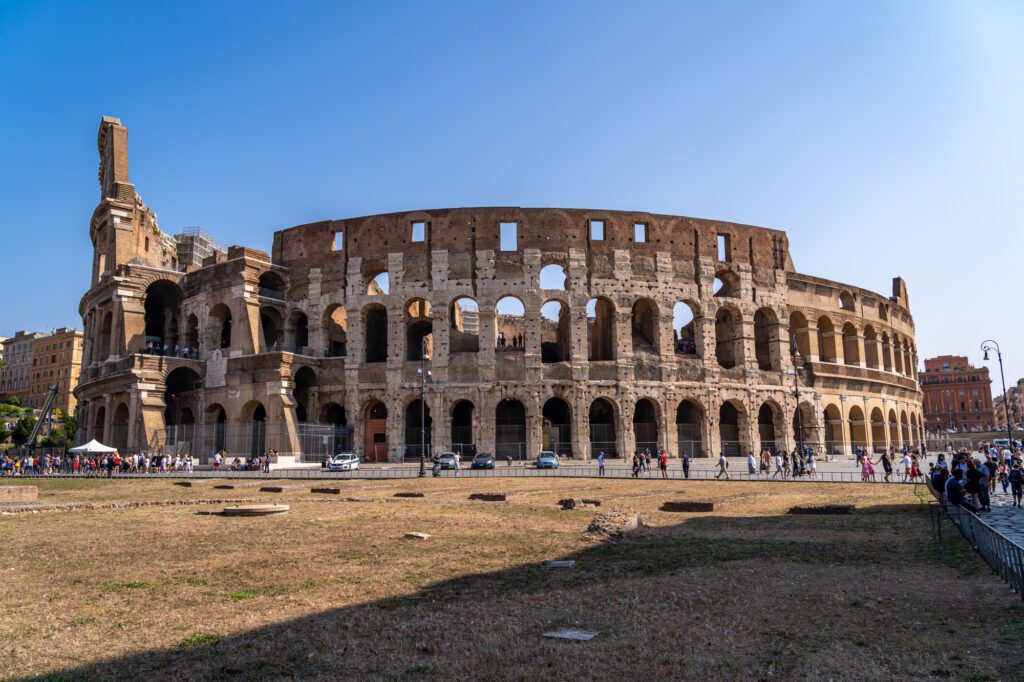
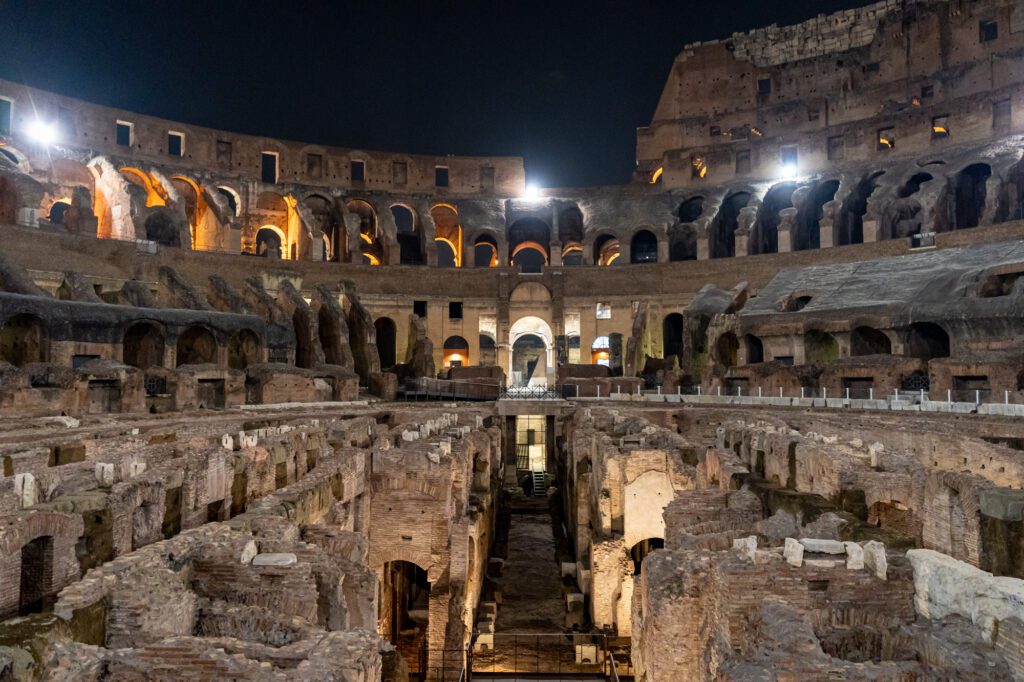
The Colosseum, in particular, is an architectural marvel to us.
The Forum is mostly just stones strewn about at this point, so it’s harder to visualize what it looked like roughly two thousand years ago at the height of Rome’s power.
Which brings us to an important point: you should definitely do a guided tour of the Colosseum and Roman Forum.
We have a strong opinion here, mostly informed by the fact that we did an amazing tour of the Colosseum with our favorite Italian tour company (you can read all about it here) where we learned that some (really, most) of the things we thought we knew about the Colosseum were actually just fairy tales.
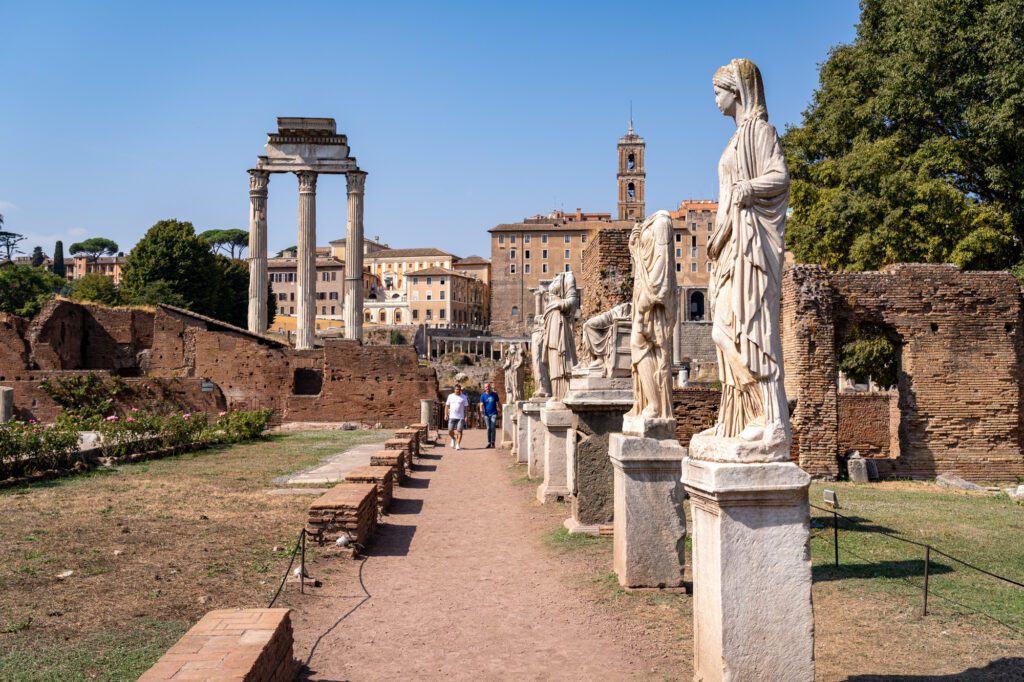
We have personally done (and enjoyed) TakeWalks’ Skip the Line: Premium Colosseum Tour with Roman Forum & Palatine Hill – you can read about our experience here (spoiler: we loved it!). It is a great tour option that includes both the Colosseum and Forum.
Before or after your visit, there’s an excellent view of the Roman Forum from OUTSIDE the boundaries located here.
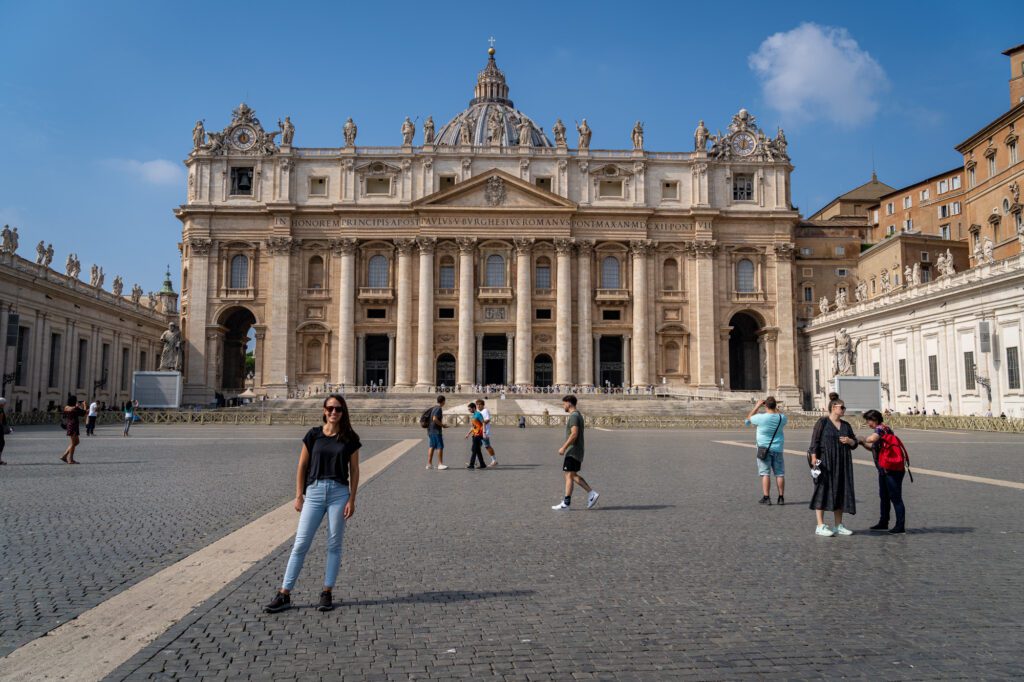
The Vatican is basically one of the greatest art museums on the planet. Sure, there’s St. Peter’s Basilica, but even that is very much about the art (which at the end of the day is just a way to show that you have money and power).
The Sistine Chapel, in particular, is incredibly moving, especially when you consider how long it took to finish, and how Michaelangelo had to paint it facing the ceiling.
It’s worth a tour of the Vatican too, if you can afford it. We’d do the “Pristine Sistine” early access tour with Take Walks, which includes early access.
We haven’t done that specific tour ourselves, but we’ve done four separate Take Walks tours now, and all have been excellent because the guides are top notch experts in their fields.
If you can only do one tour, we’d do the Colosseum and Forum because the added context and historical perspective from a guide is more useful when you’re looking at ruins.
Since we’ve already rambled so much in this section, here’s a quick hit list of other things to do in Rome.
The view from the Orange Garden (Giardino degli Aranci). This is one of our favorite views in the city, and we’re not alone. Head up here around sunset for a treat, but it’s equally gorgeous in the early morning hours (perhaps better, because the sun is generally behind you), and there are far fewer people.
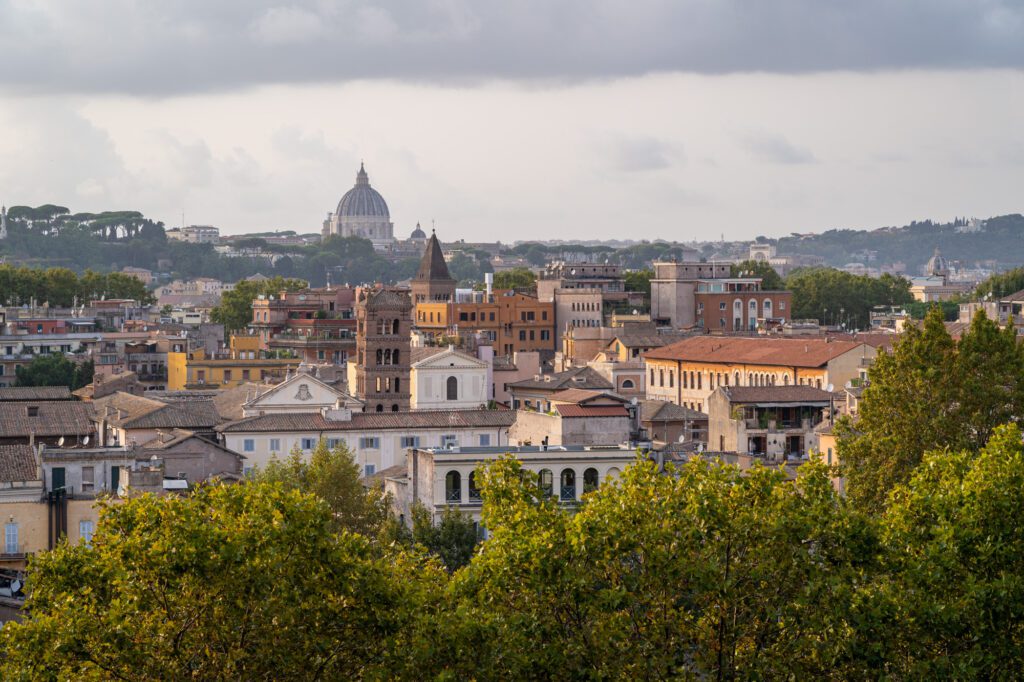
Trastevere in the evening. Our favorite neighborhood in Rome is Trastevere, and it’s not that close. It’s nice in the morning, especially if you visit the open air market that takes place at Piazza de’ Renzi, but the evening is when it comes alive. People spill out of the bars and restaurants into the streets, and the piazzas are full of people drinking and being merry.
Wine! Enoteca il Piccolo in the Centro Storico (here it is on Google Maps) is as great as it is popular. The owner came out to the terrace where I tried to explain in my bad Italian what kind of wine I wanted (dry white), and he walked away without a word, and returned with two excellent glasses of exactly what I asked for. If you’re looking for a bottle, Les Vignerons in Trastevere is the place to go (great beer and cider selection, too!).
Roman cuisine. First, we make the four Roman pastas at home (carbonara, gricia, amatriciana, and cacio e pepe) all the time. Roman food is generally very simple, but delicious. The best way to learn about Roman food is taking a food tour with a local guide, where you’ll not only taste some delicious food, but learn about the history and context behind that food. Which is our favorite part about learning about food cultures of different places. We’d do this tour, which looks truly spectacular and includes a lot of cultural context along with tons of tastings.
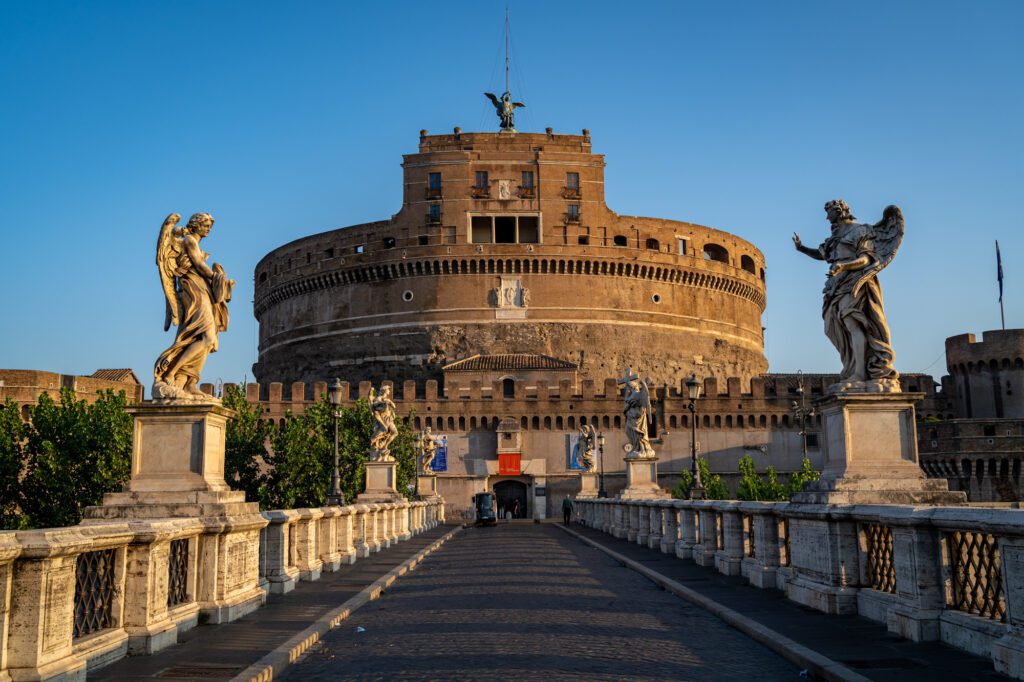
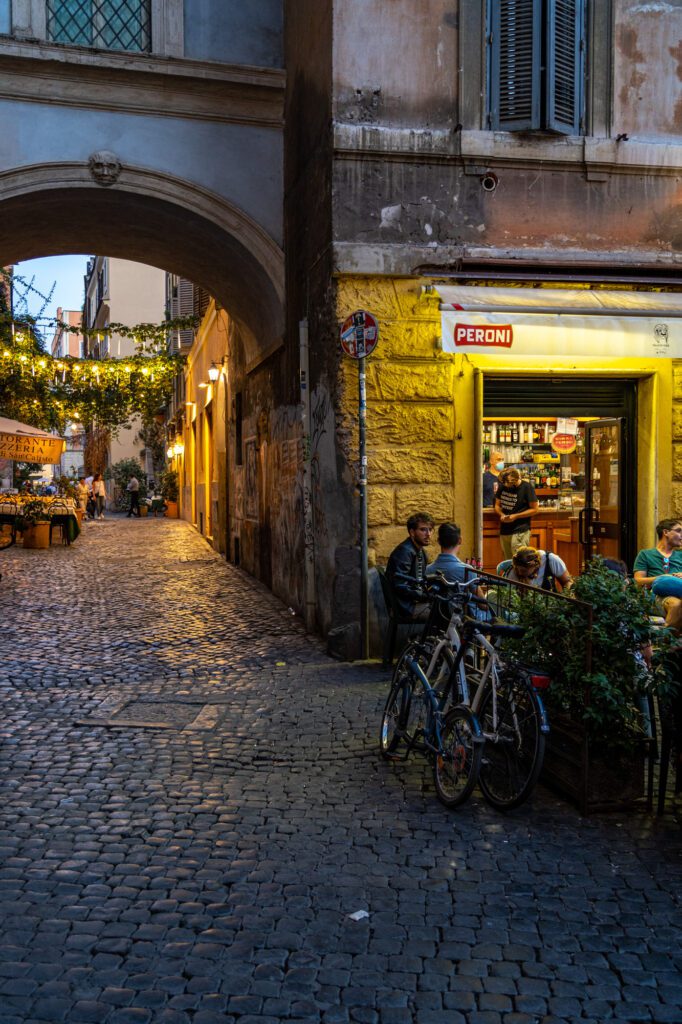
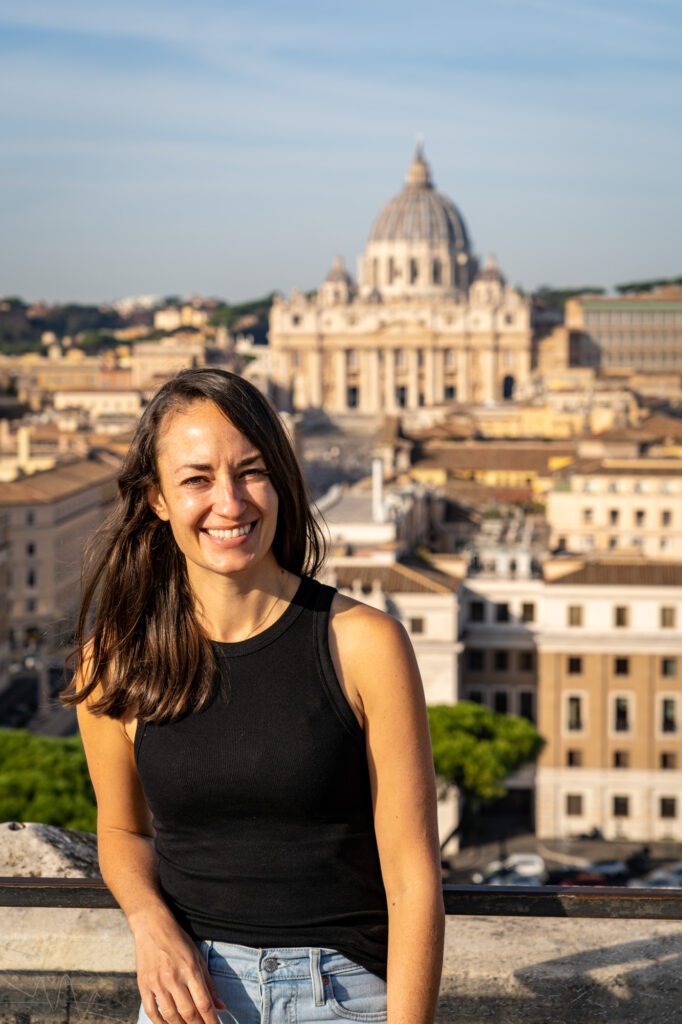
If you’re into good coffee, head straight to Pergamino Caffè near the Vatican, which is home to some of the best baristas in Rome who bring in a bunch of different Italian specialty coffee roasters to brew for you.
It’s my, Matt the coffee snob’s, favorite coffee in Rome.
Of course, there are tons of other things in the Eternal City that are worth doing, seeing, and eating. For more, head over to our guide to the best things to do in Rome, which has a collection of our favorites.
Where to Stay in Rome
While there are a bunch of areas you could stay in Rome, we have two strong recommendations for you to help you narrow it down.
We also have an entire, super detailed guide to where to stay in Rome if you want more details to make your decision.
Our overall recommendation is to stay in Trastevere, which is far and away our favorite part of the city.
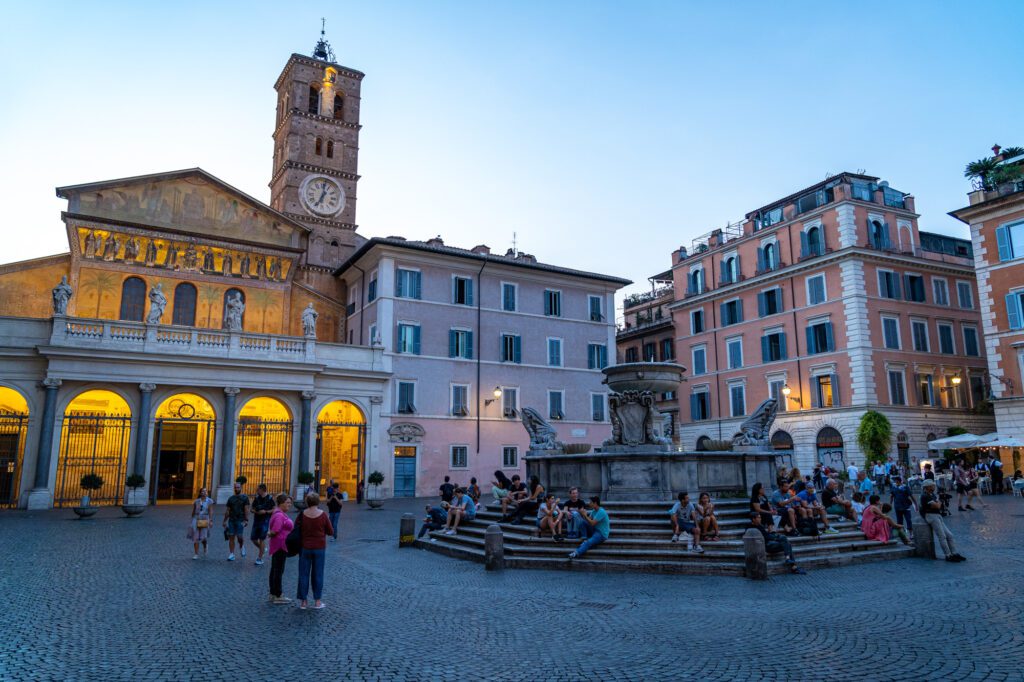
We stayed there on our last trip, and it’s magical.
It’s a great place to eat and drink, and it really comes alive when the sun goes down, full of lively piazzas and small bars and restaurants that fill up on a nightly basis and spill out into the cobblestone streets.
We stayed at Horti 14 Borgo, a small boutique hotel in Trastevere, and absolutely loved it.
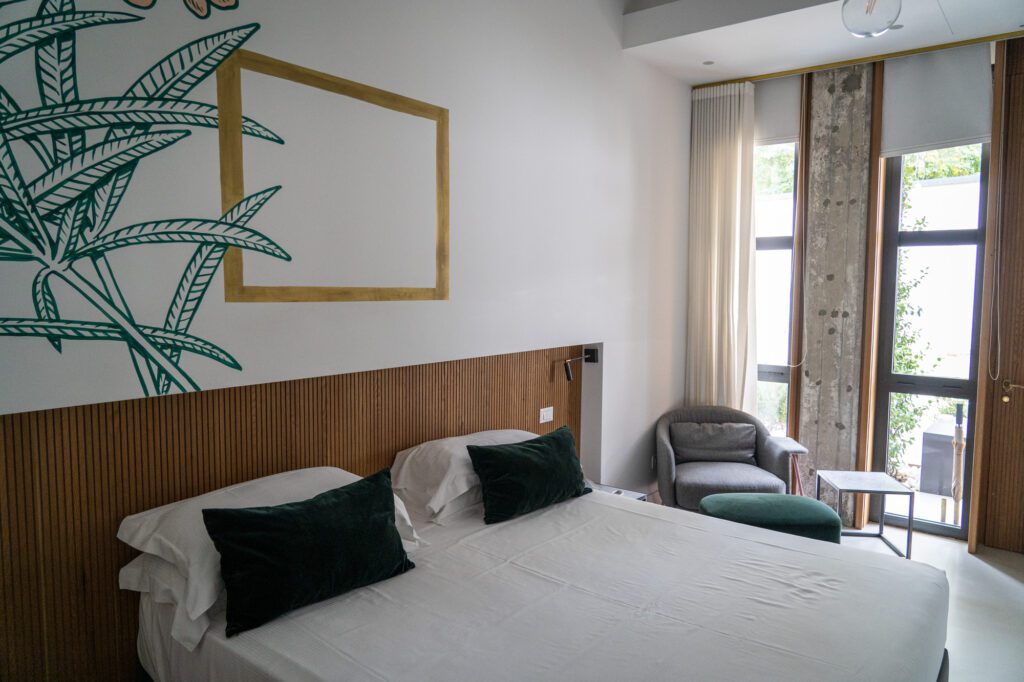
It’s a splurge compared to where we normally stay, but the stylish rooms, comfortable beds, and incredible breakfast buffet were worth it.
A more affordable (but equally highly rated) option would be Ripagrande a Trastevere, which is essentially right on the River Tiber and within five minutes of everything in Trastevere.
The only downside to Trastevere is the fact that it’s a little far from the train station, which doesn’t matter as much with three days, but is a little less convenient (you’ll need to take a taxi, most likely).
Which brings us to our second recommendation, which is Rome’s Historic Center (the Centro Storico).
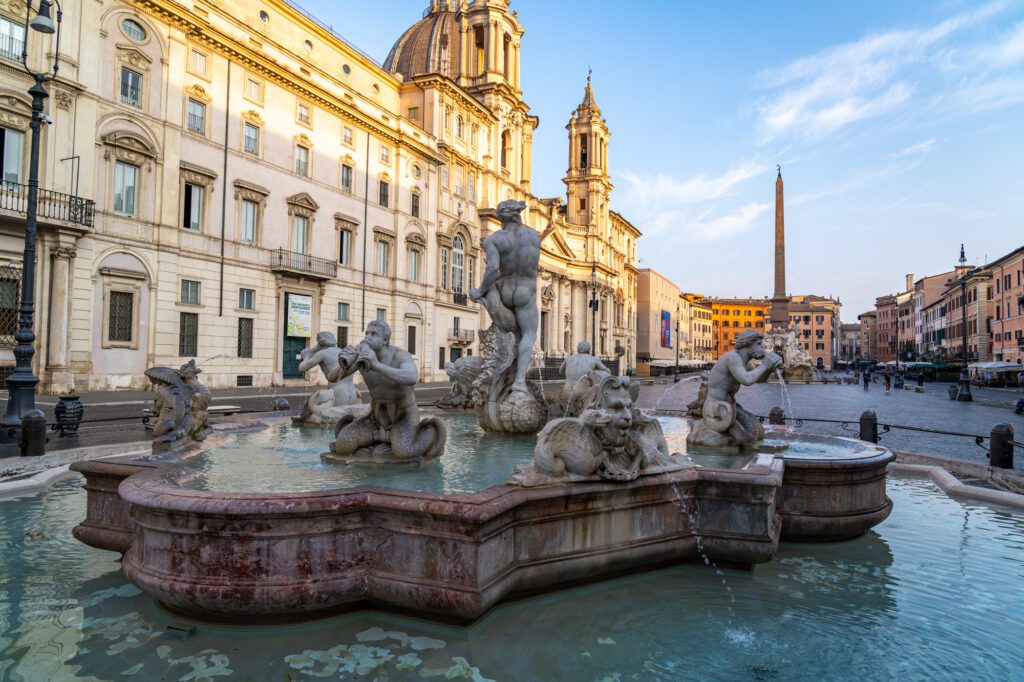
Stay here if you want to be right in the middle of all the action, within walking distance to just about everything in the city.
It’s the most convenient place to stay, though it will be crowded and potentially loud. Don’t miss an early morning walk from Piazza Navona to the Trevi Fountain and the Spanish Steps!
We stayed for five nights near Piazza Navona at these apartments, which were honestly a perfect location, especially if it’s your first time in Rome.
Coronari Palace and Casa Pietra are two hotels that were also on our list, though we decided we wanted more space and a kitchen for our time in Rome.
Florence: Days 4-6
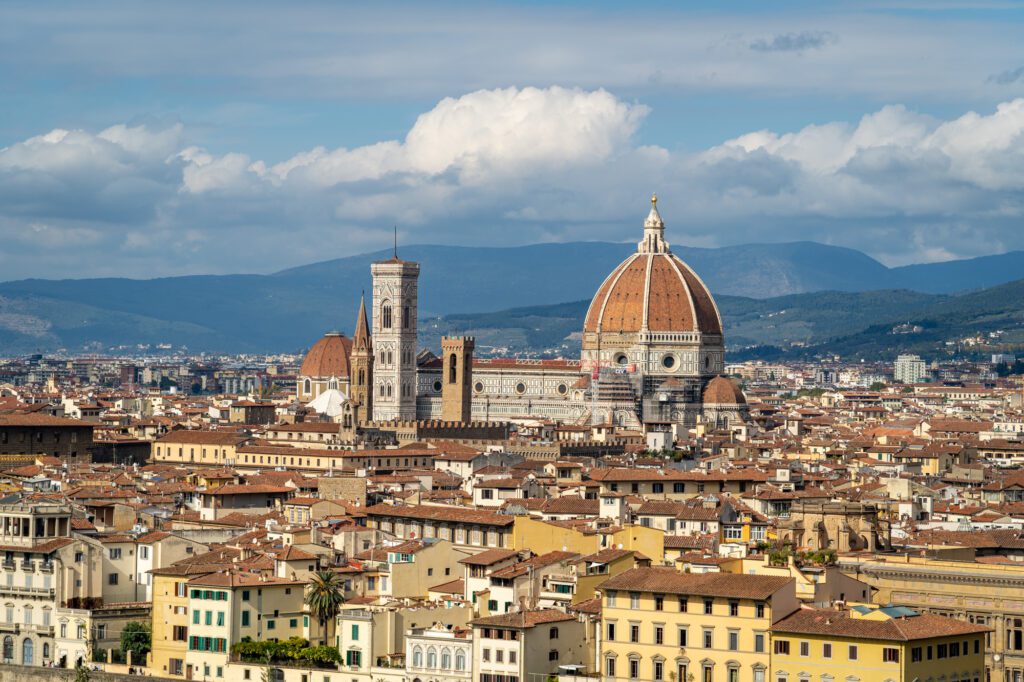
Historically, the city of Rome might be the crown jewel of the Roman Empire, but you could make a convincing argument that Florence is the second most important city in the history of the Italian peninsula because of its influence around the birth of the Renaissance.
On a walking tour in Florence (this one, which we recommend below because it’s a great introduction to the city), as we were walking through Piazza della Signoria, our guide made a point that I hadn’t really thought about before that moment.
Florence was one of the richest cities in Europe (if not the world) in the 15th Century and through the Renaissance.
A lot of people – myself included – might think that wealth came from the amazing art that was produced in Florence leading up to and during the Renaissance.
But the truth is that Florence was already a rich city thanks to silk production, and that wealth is what allowed it to become a cultural icon that thousands of people still flock to five centuries later.
Walking the streets of Florence, it’s easy to see why so many people fall head over heels in love with it on their visit.
It’s charming. The Duomo is incredible, both because of how imposing it is, and the fact that it’s an architectural miracle. There are two world class museums.
The food and wine are both excellent (definitely get the wild boar if you see it on a menu – pappardelle al cinghiale – which was our favorite discovery on our Tuscany road trip itinerary).
I could go on and on about Florence – I’ve spent over a week in Florence between two trips in the past year (at the time of writing) – but let’s leave it there and get into how to make the most of your time in the Tuscan capital.
In this itinerary, we have you spending two and a half days in Florence itself, and then using it as a home base for a day trip into Tuscany.
What to Do in Florence
There are two main attractions in Florence that you’ve likely heard of before, and both are well worth your time.
They are the Uffizi Gallery, which is a chronological journey through Renaissance art in Florence, and the Galleria dell’accademia, which is where you’ll find Michaelangelo’s David.
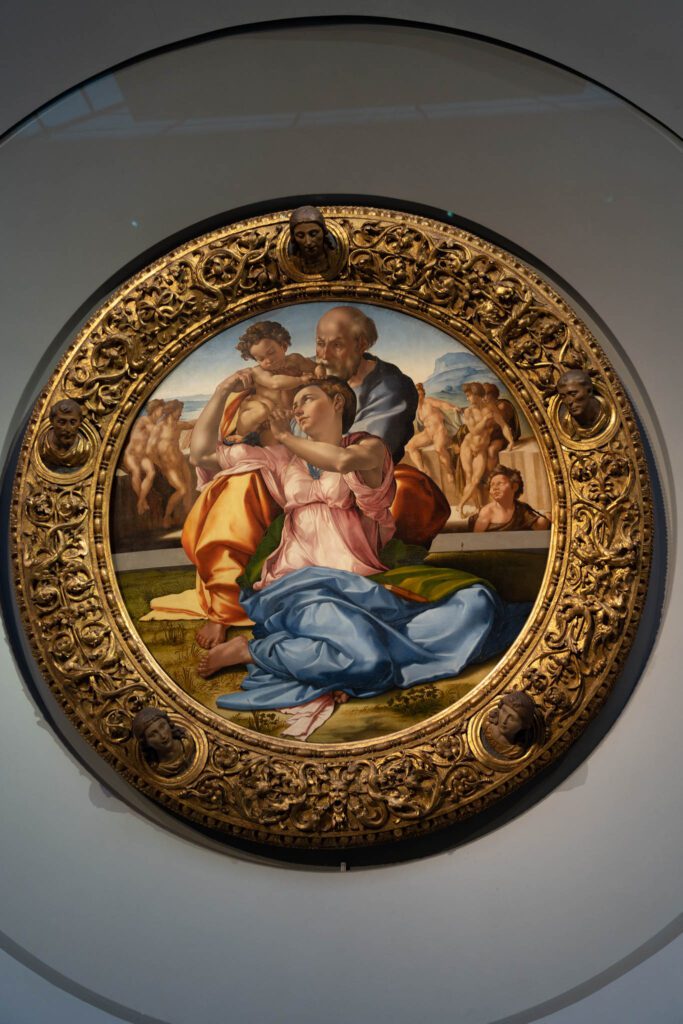
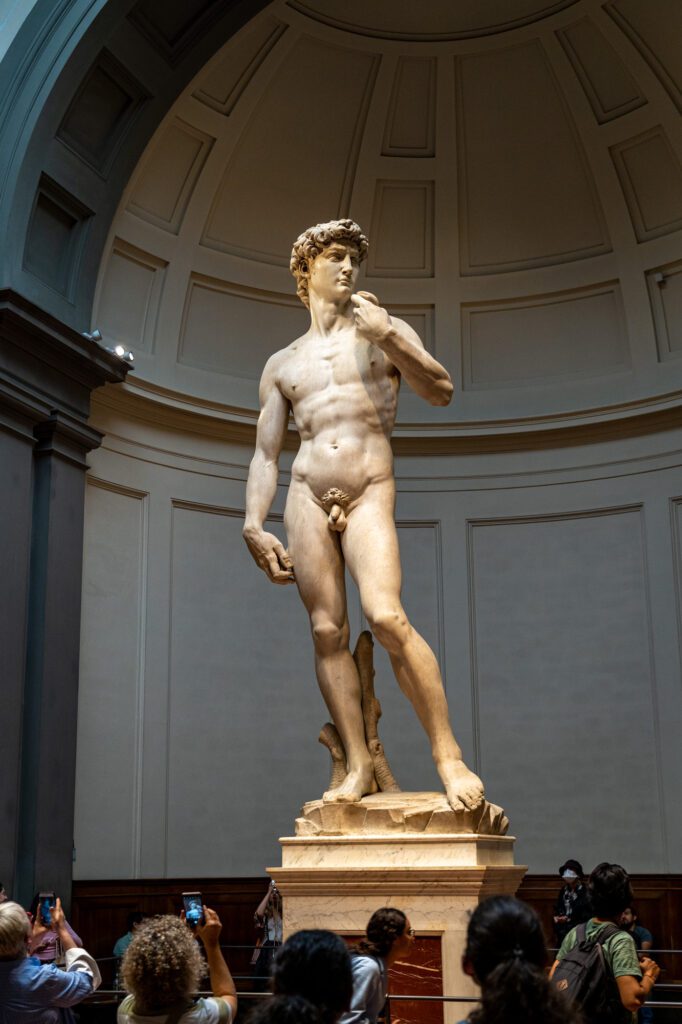
However, you should definitely try to do them on different days, because it’s too much information to process in a single day.
Believe me, my mom and I tried to do both in a day in Florence on my latest trip to Italy, and it was too much.
The other thing I would say – and again, I’m speaking from experience here having done both museums with and without a guide – is that you should invest in a guided tour with an art historian if you can.
After some truly great experiences recently, I’ve decided that I probably won’t do a huge art gallery like the Uffizi or the Louvre without a guide ever again.
The guide is able to add so much in terms of color, context, and storytelling that will give you a deeper connection to just about any museum visit.
Otherwise, we’d look at the art, say “yeah, that looks pretty,” and move on without really understanding the context behind what we’re looking at.
If you only have the budget for one, make sure to do the guided tour of the Uffizi, where your guide will be able to explain exactly what you’re looking at, and what it says about the changing nature of society and culture during the Renaissance.
We did this guided tour of the Uffizi Gallery, and it was fantastic.
For what it’s worth, I (Matt) also did this guided tour of the Galleria dell’Accademia on my last visit with my mom, and we also really enjoyed it.
However, like I said above, if you only have time or budget for one tour, you’ll get more out of the Uffizi.
For more information, including on how to visit both galleries independently, head over to our guides to the best things to do in Florence and our guide to planning your Florence itinerary.
As we said above, we’d split those two museums up and do one on each of your two full days in Florence. Which, obviously, leaves you with some extra time. Here’s what we’d do with that time.
Take Andrea’s walking tour. We’re huge fans of walking tours as a way to get an introduction to a new city and connect with a local for tips on what (and where) to eat, drink, and shop. And we loved Andrea’s walking tour, which is a two hour crash course in Florence’s rich history, with all the salacious details about the Medici family (they were essentially royalty in Florence during the 1500’s). He also has a more in-depth version of the tour that adds an hour and includes crossing the river to Oltrarno.
Climb to Piazzale Michelangelo. On the other side of the river from Florence’s Centro Storico, you’ll find what is arguably the best view of the city at Piazzale Michelangelo. You’ll have a view of the Arno River and Ponte Vecchio (the only bridge in Florence that wasn’t destroyed in World War 2), the Duomo, and the rest of the city. It’s nice at sunset, but it’s busy. Early in the morning is even better, because the sun is behind you and there are basically no crowds.
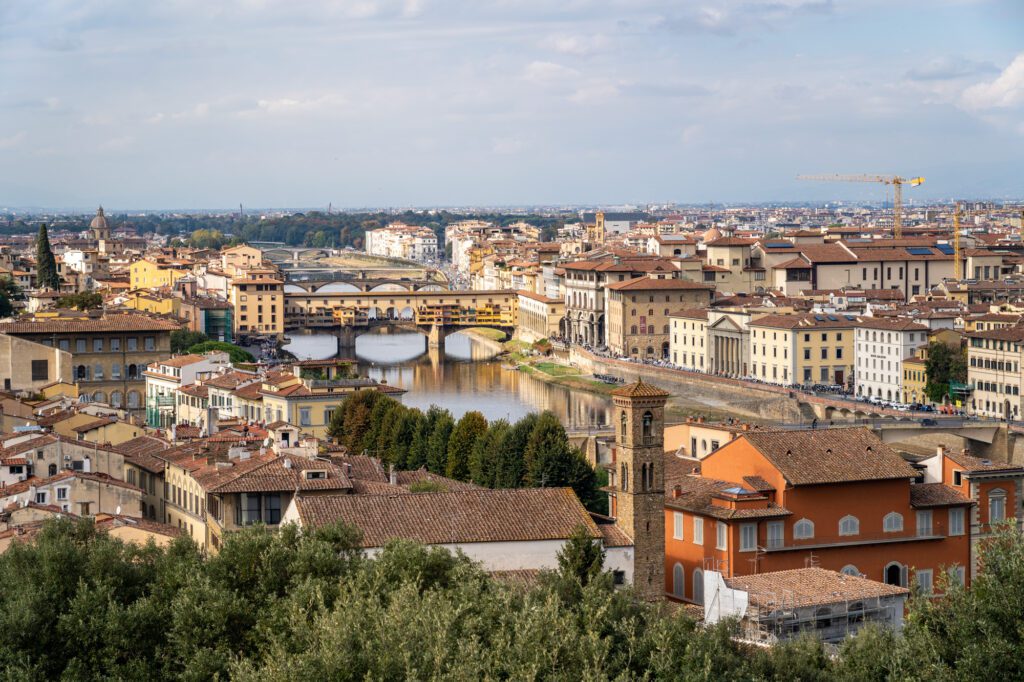
Climb Brunneleschi’s Dome. The Duomo in Florence is massive. The best way to experience it, in our opinion, is to climb to the top. Along the way, you’ll get a view of the interior of the dome and the (somewhat creepy) artwork decorating it, then you’ll climb through the area between the interior and exterior dome (which gives you perspective on how it was built 600 years ago, which is mind-boggling) up to the top, where you’ll have a 360-degree view out over Florence. Try to do it first thing in the morning for the fewest people, and book in advance here.
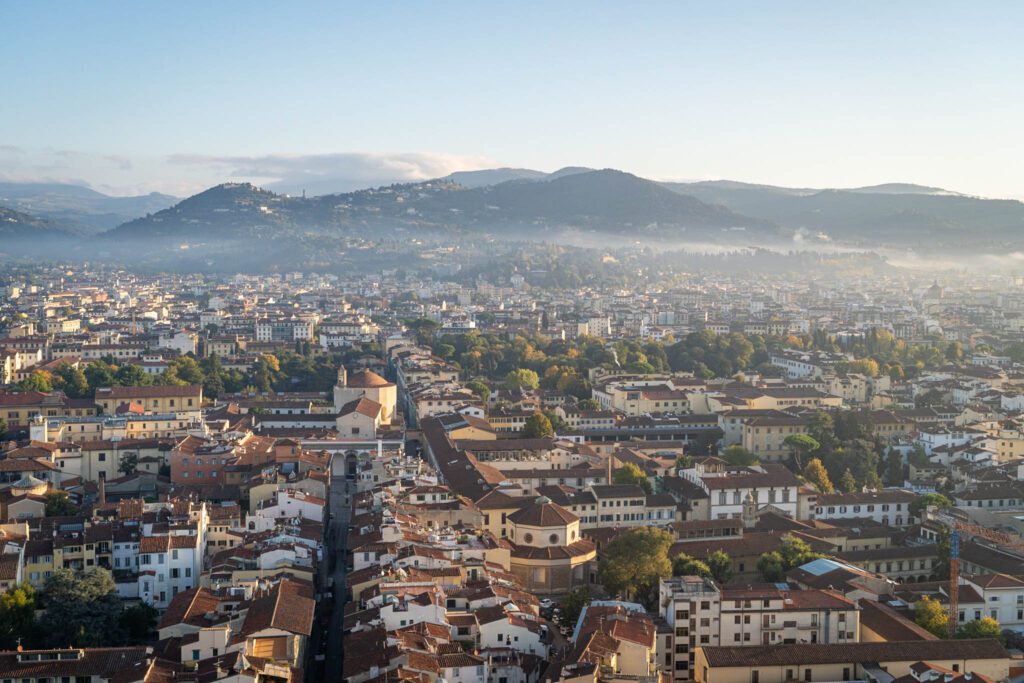
Dive into Tuscany’s food and drink offerings. We’d strongly encourage you to skip the pizza in Florence, and instead indulge in some of the local specialties. We love Pappardelle al ragu di cinghiale (a pasta with a wild boar sauce that my mom fell in love with), pappa al pomodoro (tomato and bread soup), and the Schiacciata (sort of like a focaccia sandwich, but slightly different). We liked the food at Trattoria da Garibardi. Most of the Florentine cuisine pairs well with the Tuscan reds like Chianti Classico and Brunello, which are a couple of the more prestigious red wines to look for.
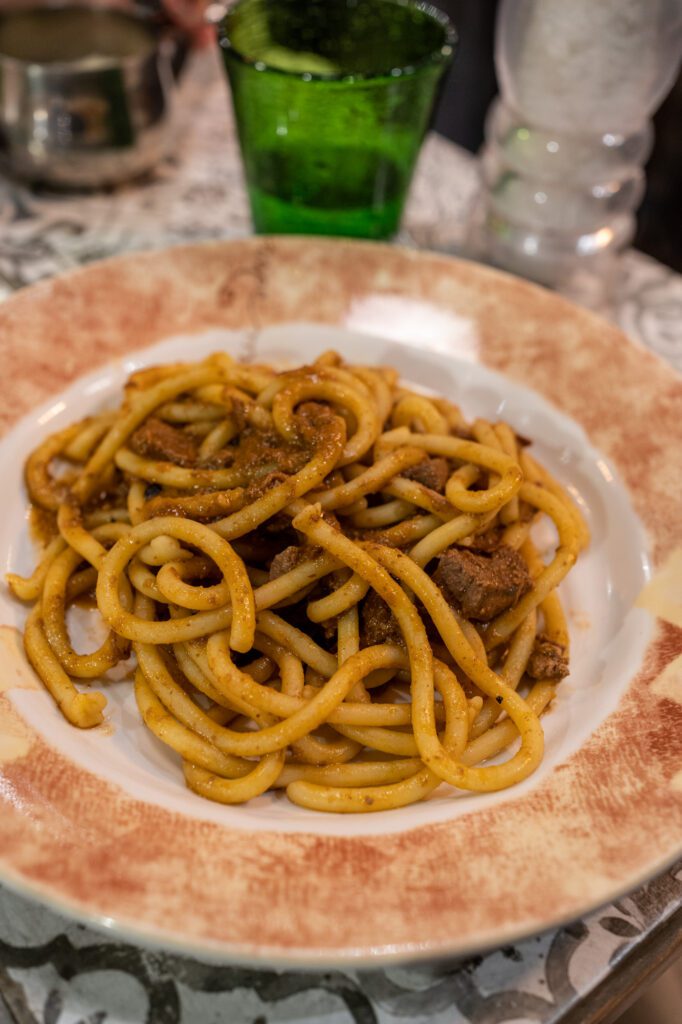
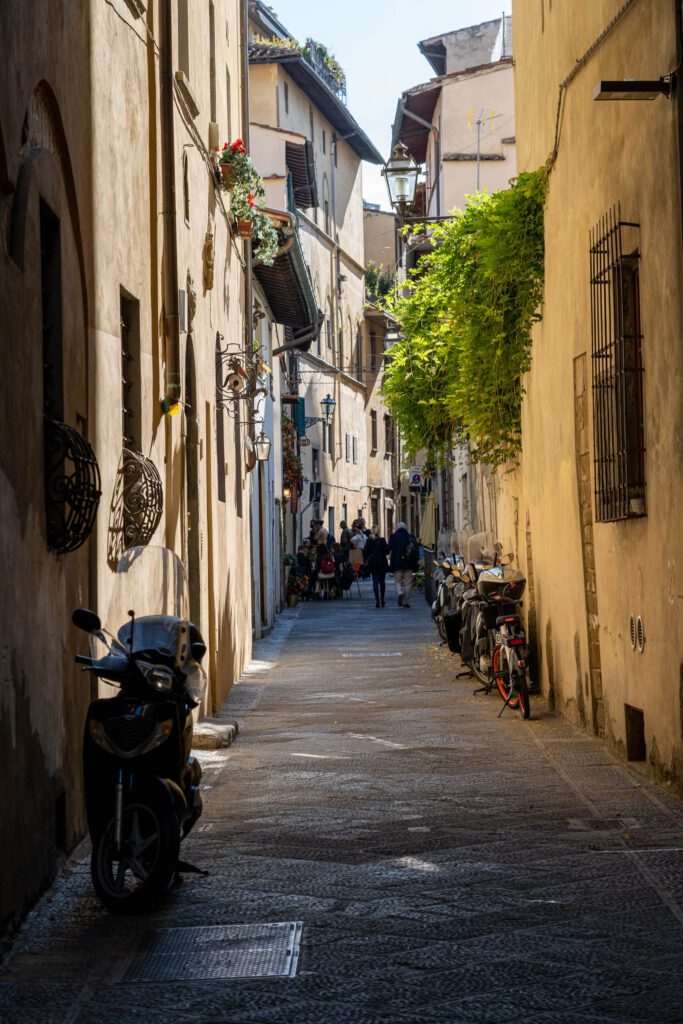
Where to Stay in Florence
Similar to Rome above, we have two recommendations for where to stay in Florence.
Also similar to Rome, your choice is going to be between the coolest neighborhood (in our opinions, anyway) and the most convenient area.
Convenience matters a little more here because you will be taking a day trip, which means you’ll be going to and from the train station.
Our favorite area in Florence is Santa Croce / Sant’Ambrogio, which is a five minute walk east of the Duomo. It has the best food (we think), fewer tourists, and is close to everything in the city.
We stayed at Pietrapiana Boutique Apartments for almost a week, and it was everything we wanted and more: access to a kitchen, a little more space to spread out, a quiet refuge from the hustle and bustle, and a comfortable place to sleep. Highly recommend!
La Maison du Sage is another good option nearby – it’s more of a traditional hotel than serviced apartments.
The other option, which is best if you want to be super central to everything in Florence, is Florence’s Centro Storico, which is centered around the Piazza del Duomo and nearby Piazza della Signoria (home to the Uffizi Gallery).
It’s crowded, it’s loud, but it’s super convenient. It’s also closer to the train station for your day trip.
Day Trip from Florence (Choose Your Own Adventure): Day 7
Florence is the capital of Tuscany, which might be Italy’s most famous region for its wine and general dolce vita feeling. And, after spending a week in Tuscany, we can definitively say it delivers on both.
Florence is an excellent base to explore Tuscany from, with most of the highlights accessible within 90 minutes by train. However, the main issue with Tuscany is that you really need a car to be able to see certain things properly.
Here are the three day trips from Florence we’d recommend, and which one you choose totally depends on what you’re interested in.
If you’re looking to combine San Gimignano, Chianti, and Siena into one day, it’s going to be a long day, but this tour with Take Walks (which, as we’ve already mentioned a few times in this guide, is one of our favorite tour companies on earth), covers San Gimignano, Chianti, and Siena in one action-packed 10 hour day.
Day Trip 1: Siena for the Cathedral (and the History)
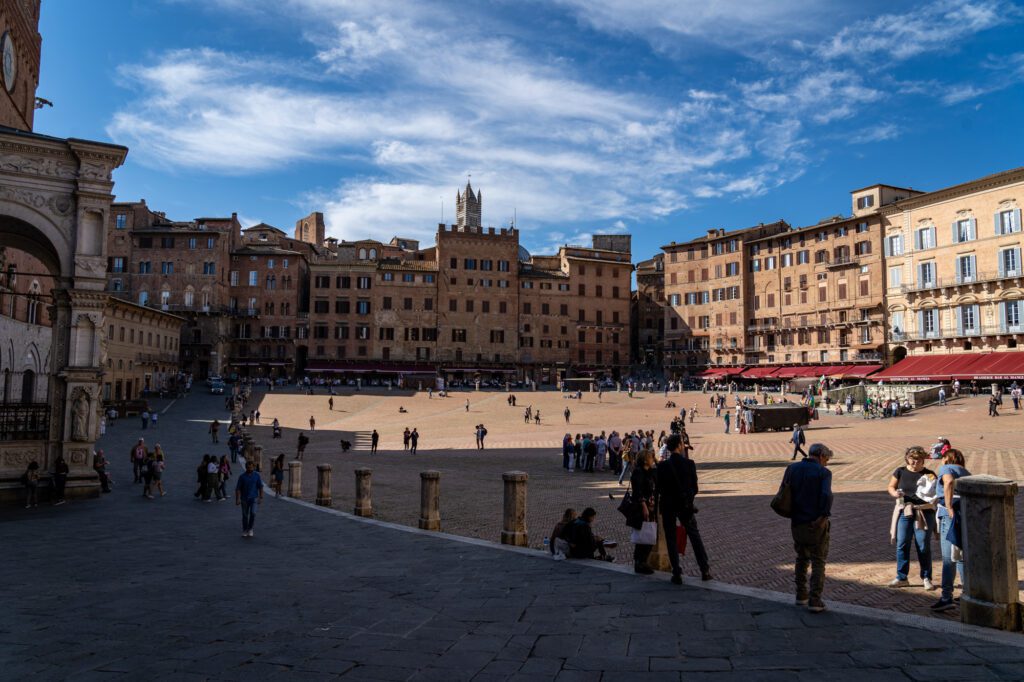
Siena is a popular day trip from Florence, and it’s a 90 minute train ride south in the heart of Tuscany.
There is, perhaps, no better example of a classic hilltop town than Siena, which is a red city perched on a hill overlooking a lush green valley.
The cathedral in Siena is incredible, and we say that as people who usually don’t get all that excited about massive opulent churches.
The iconic dark green and white stripes of Siena’s Duomo are just the beginning of what makes it special.
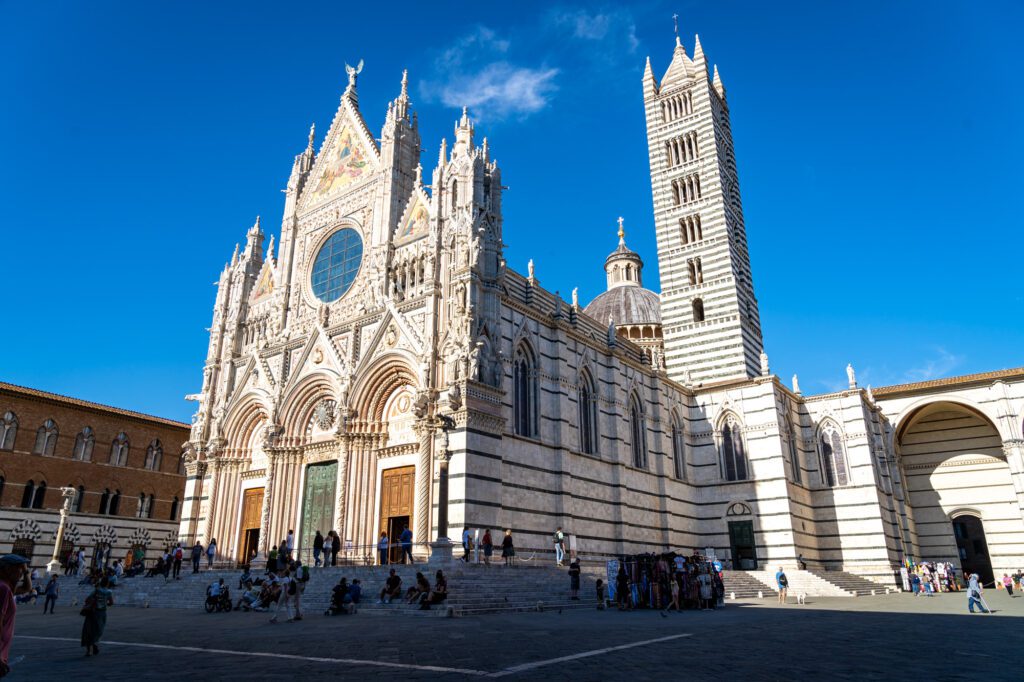
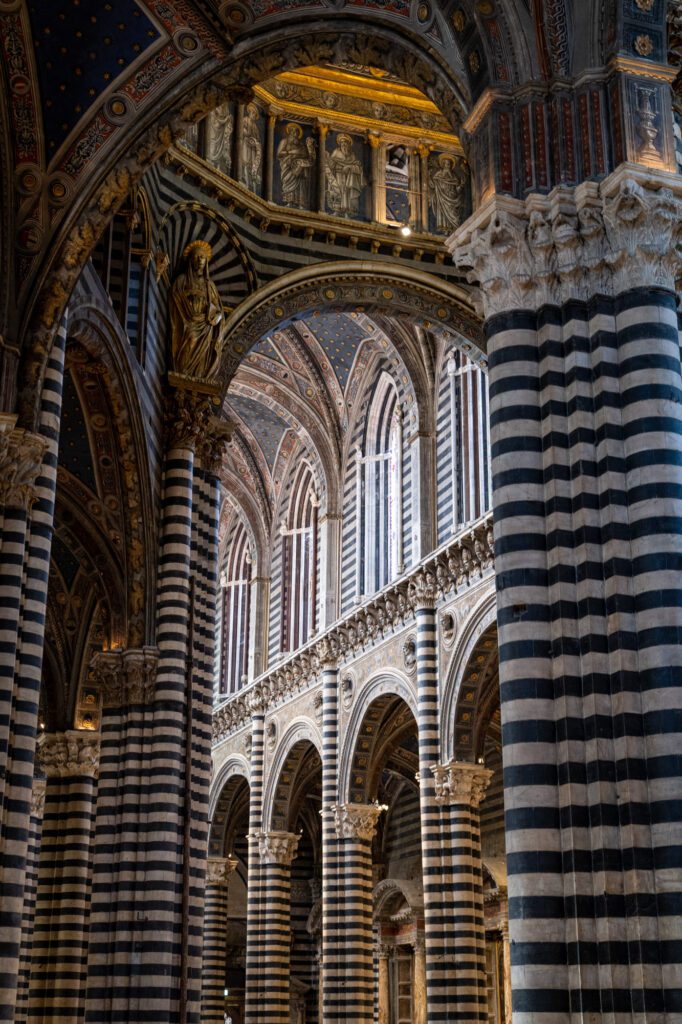
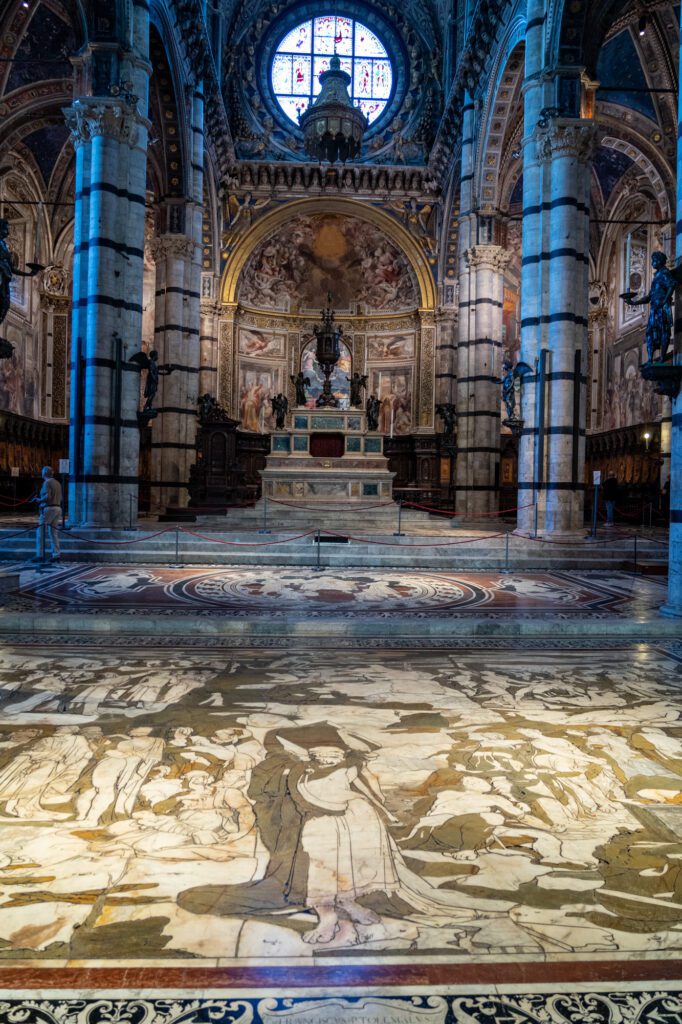
The interior is where the real fun begins, particularly if you’re around when the floors are uncovered (usually in the summer), and the intricate art and tilework on the floors is on full display.
We recommend climbing up to the Facciatone, which is a viewpoint inside the Museo del Duomo that has an excellent view of both the cathedral and the surrounding landscape.
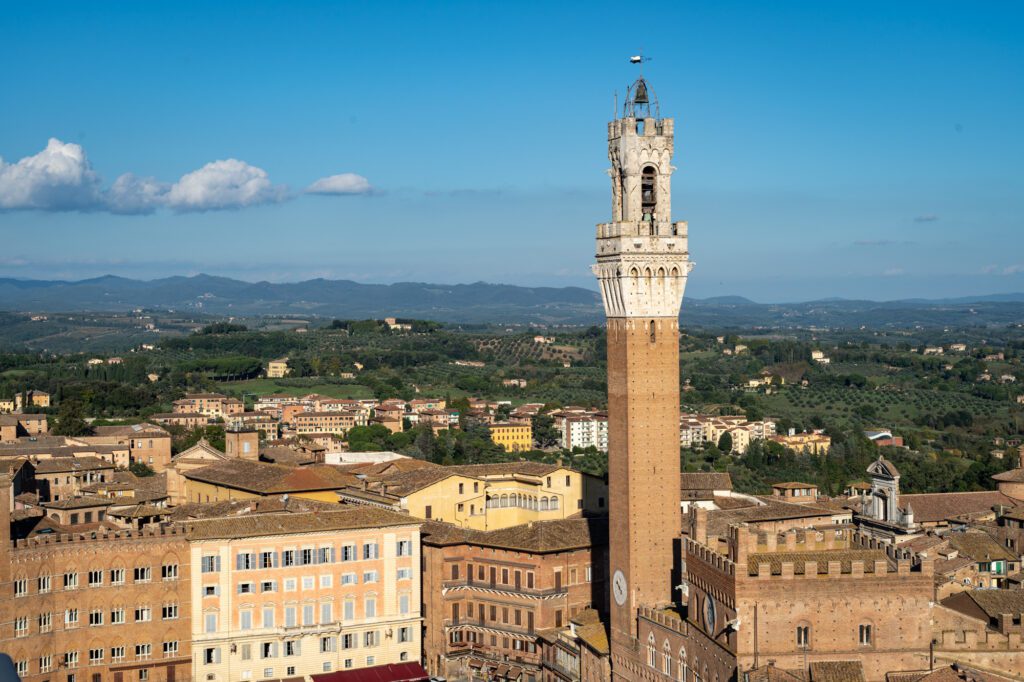
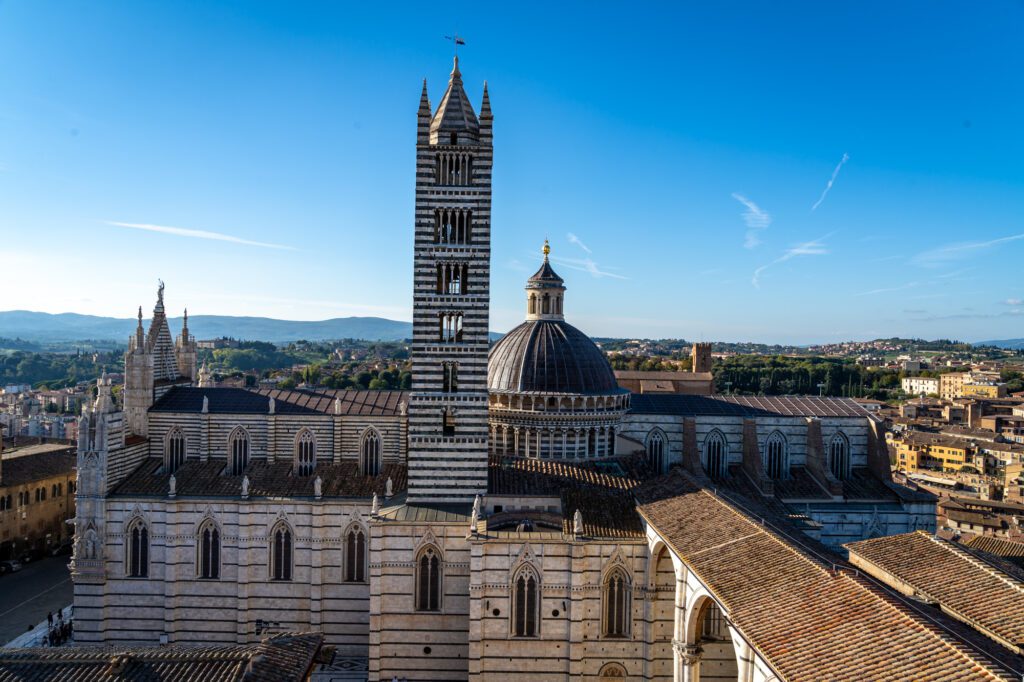
The other place not to miss in Siena is Piazza del Campo, which rivals Piazza Maggiore in Bologna (more on that in a second) as our favorite piazza in all of Italy.
In terms of eating and drinking, head to Torrefazione Fiorella for a morning coffee at a stand-up bar (very Italian), Panificio Il Magnifico to try sweet Sienese specialties like ricciarelli, Du’ Cose Da Berna for traditional sandwiches at lunch (a recommendation from our friendly host at the agroturismo we stayed at outside of Siena), and Ristorante Gallo Nero, which was one of the best meals we had in Tuscany.
How to get there: There are regional trains between Florence’s Santa Maria Novella (the main station in Florence) and Siena that take about an hour and a half. You can also take bus 131 (or the faster 131R) from the Florence bus station (here on Google Maps – it’s right next to Santa Maria Novella), which is a similar amount of time. Both are very affordable options.
Day Trip 2: Chianti for the Wine
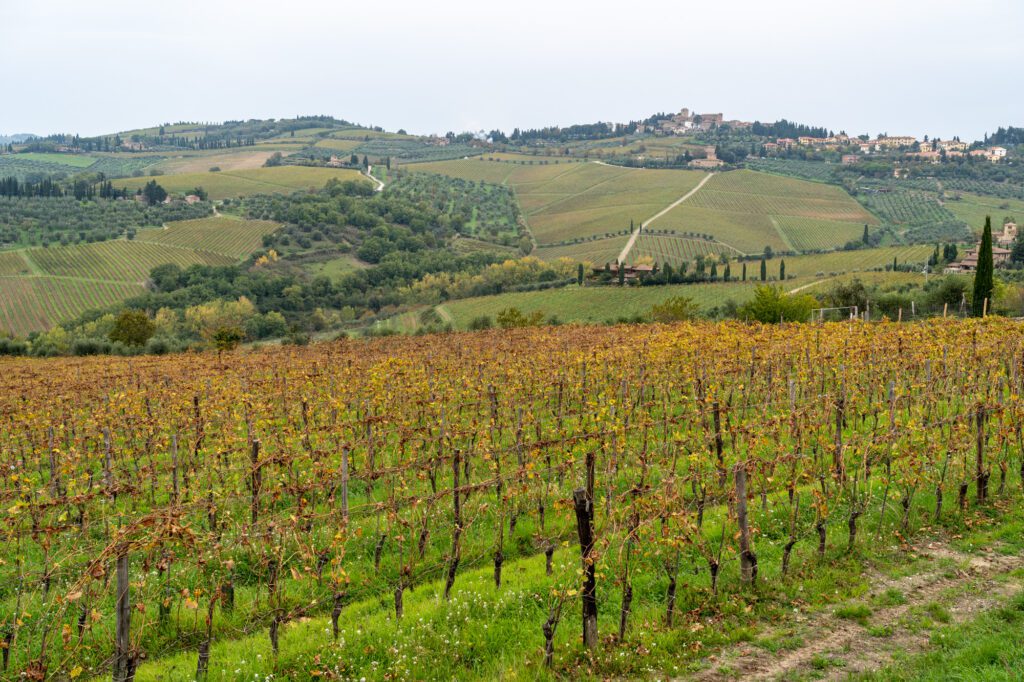
Chianti is the place to go for wine. Chianti classico is the name of the game here, which is a Sangiovese-based red wine that follows strict production methods, and is one of the most famous wines that comes out of Italy.
If you don’t like red wine, I have some bad news for you – Tuscany is all about the red wines (except for vernaccia, which is a white wine that comes from San Gimignano!).
Assuming you don’t have a car, your only option here is to do an organized tour because doing a self-guided tour of Chianti wineries would require both a rental car and a designated driver.
In terms of guided tours, you have two options.
You can either choose a tour that goes deep on a single winery, usually including a cellar tour and detailed tasting (but you’ll have to make your way out to the winery), or a tour that takes you around to multiple wineries, which is going to be a little less personal, but give you more breadth where you’ll get to see multiple approaches AND usually includes transportation to and from Florence.
We did this tour of a tiny organic winery and olive farm at the northern end of Chianti, and we loved it.
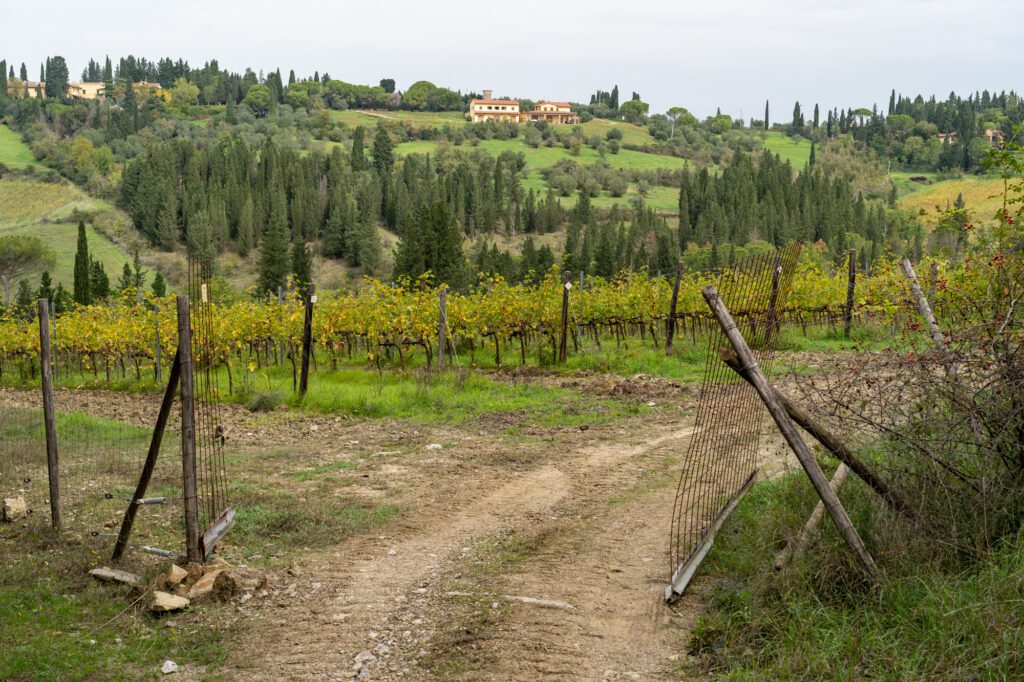
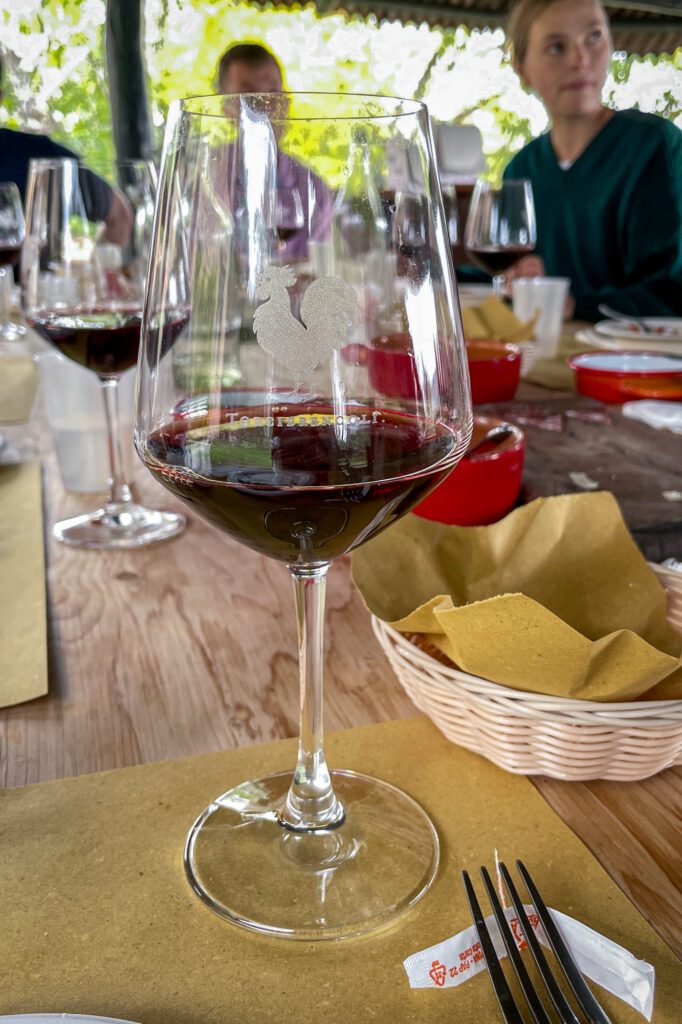
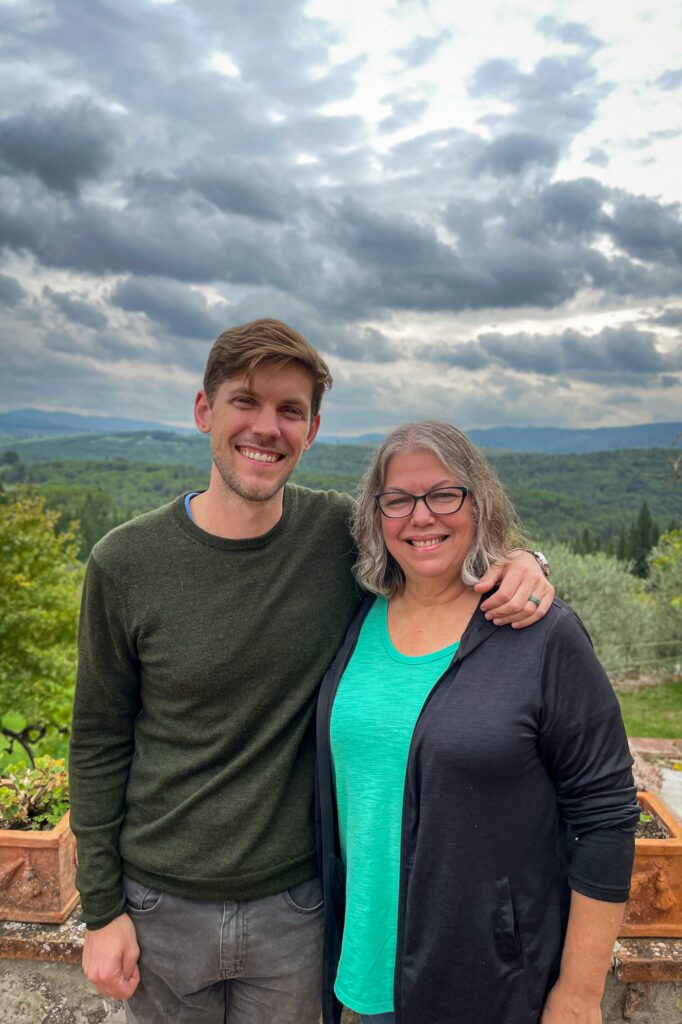
It was very personal and intimate, and we learned a ton about growing grapes (and olives) in Chianti.
We’d highly recommend it, and the nice part is that it’s easily accessible from Florence (and the hosts will help you figure out how to get there, including a bus station pickup).
In terms of the other option where you get to visit multiple wineries with transportation to and from Florence, this is a highly rated tour with a sommelier that we considered.
You’ll get to visit three wineries, which are all closed for public visits, which is a good sign that it’s a unique experience because the host clearly has relationships with those specific wineries.
If you want to see more of Chianti, including the super charming Badia a Passignano, we’d go with this tour.
Day Trip 3: Lucca For the Views
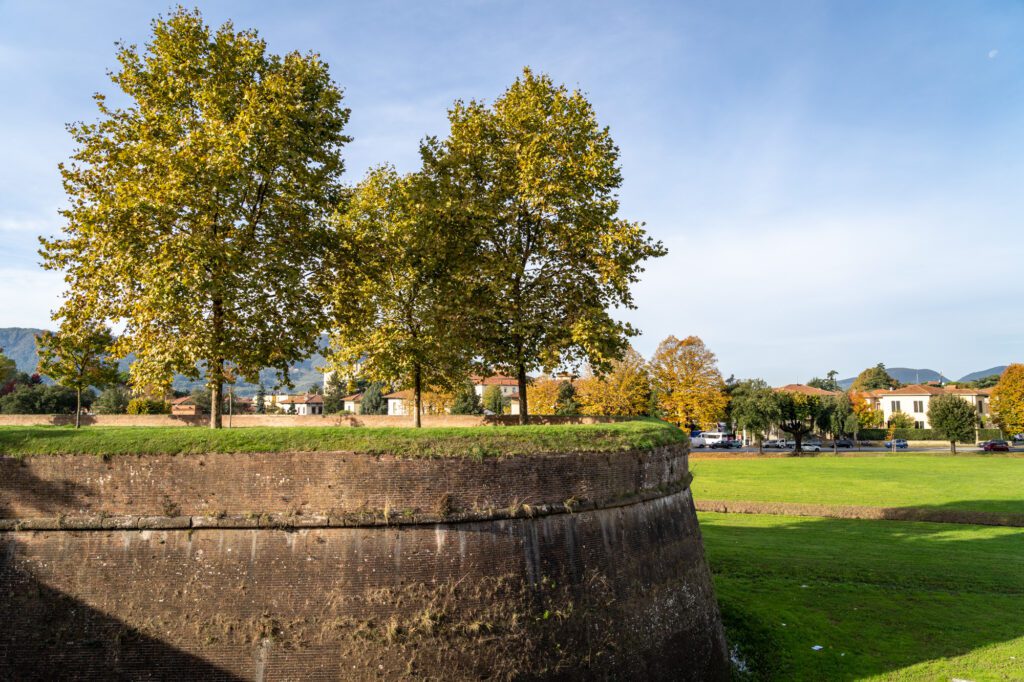
You might have been expecting to see Pisa somewhere on this list of day trips from Florence, and we’re here to tell you that while, yes, the leaning tower is kind of cool, we would absolutely recommend skipping Pisa (which is crowded beyond belief with people wanting to see the aforementioned leaning tower) and heading to Lucca instead.
There are a couple of reasons we love Lucca.
First, the medieval walls are still intact, encircling the entire city. It’s well worth walking the full loop, where you’ll get some nice views of the city and the mountains beyond.
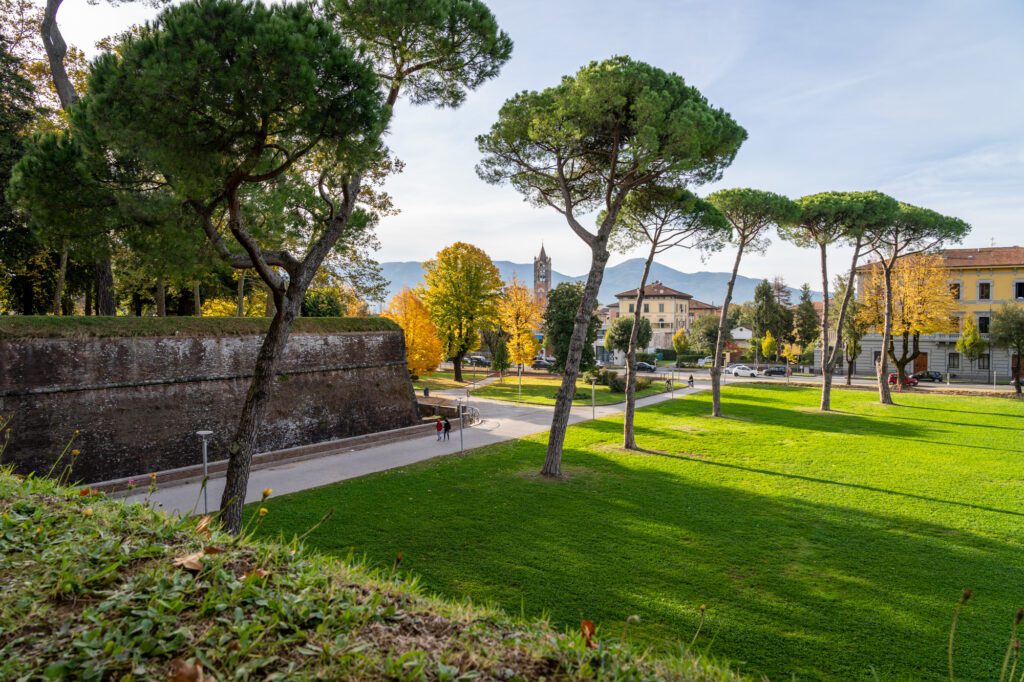
Second is the tower. Climbing the Guinigi Tower will take you up to what might just be our favorite view in all of Italy.
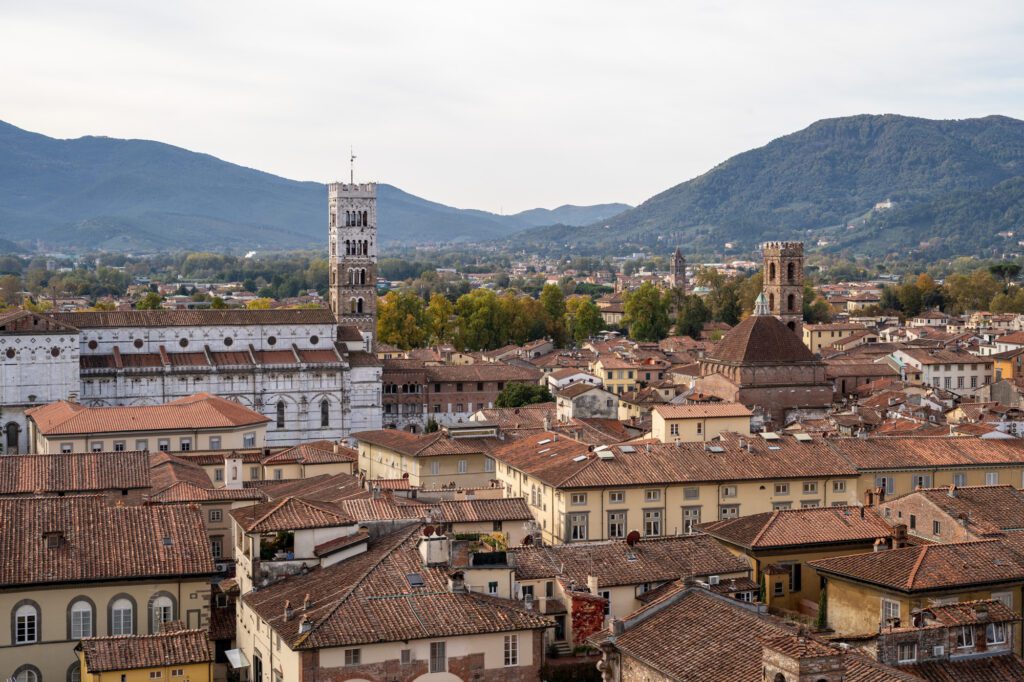
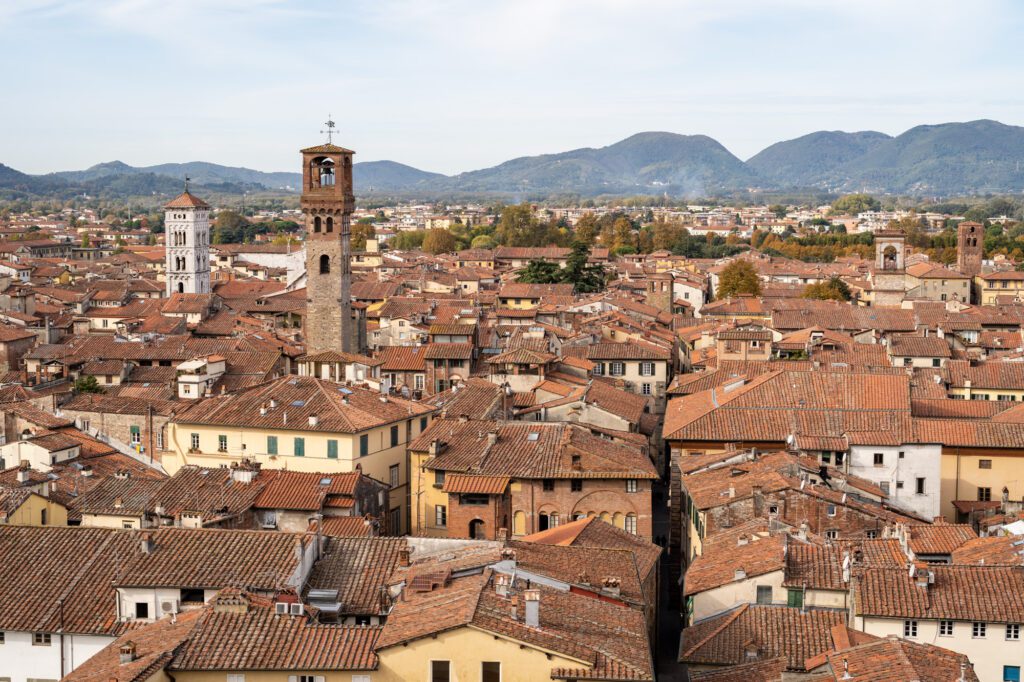
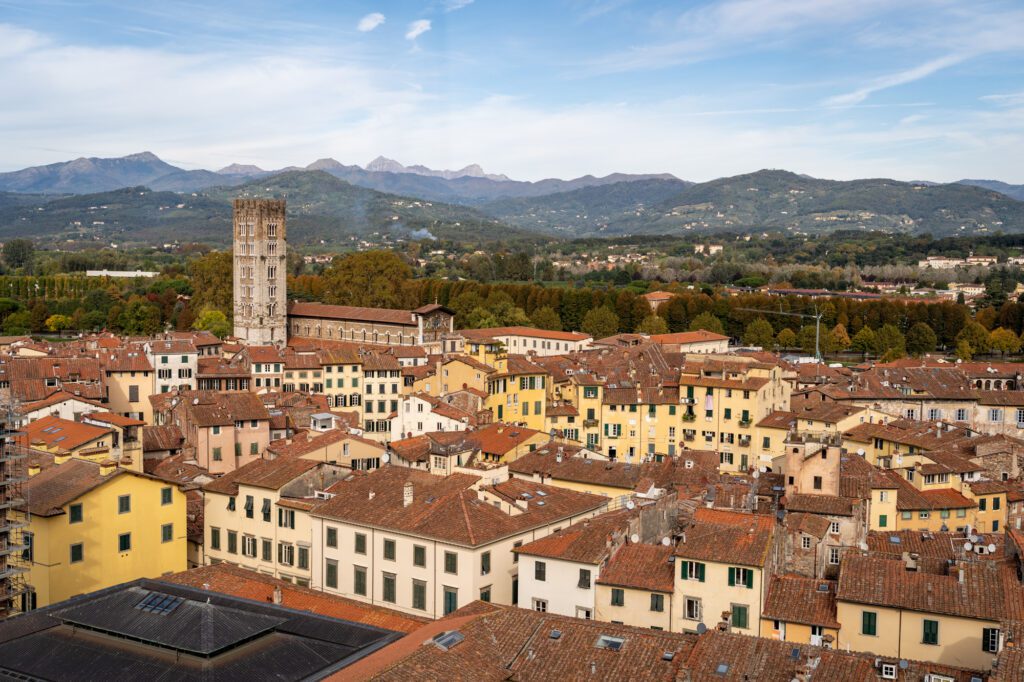
On a day trip to Lucca, we’d spend your time walking the city walls, climbing the tower, and indulging in some Luccan cuisine for lunch (at Trattoria L’ Angolo Tondo, which is right on the Piazza dell’Anfiteatro where a Roman amphitheater used to be), which is slightly different than the food you’ll find in Florence because of its proximity to the coast, which means more fresh seafood.
How to get there: There are regional trains between Florence’s Santa Maria Novella (the main station in Florence) and Lucca that take about an hour and a half. They come frequently, and they’re super affordable.
Bologna: Days 8 & 9
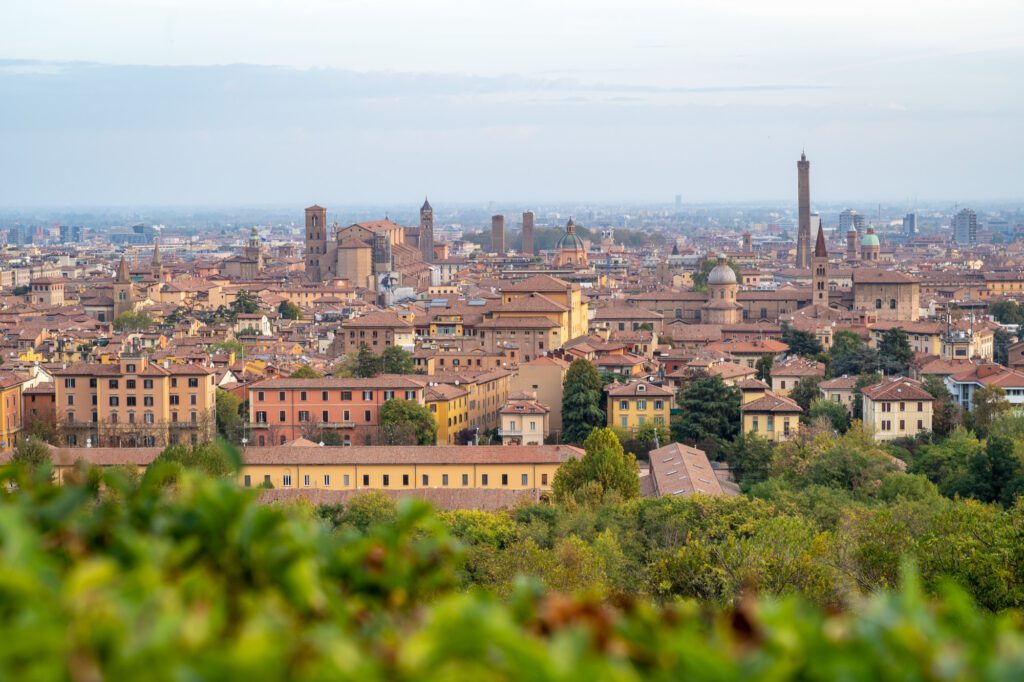
You’re probably a little bit surprised to see Bologna on this itinerary, since it’s not exactly known as one of the “must-see” cities in Italy. However, we’re here to tell you that it absolutely should be on your list, particularly if you love food.
One of the most interesting parts about traveling to Italy is having our expectations about “Italian” food completely shattered.
Here in the US, Italian food (we now know that Italian–American food is an entirely separate thing) consists of heavy sauces with lots of garlic, garlic bread, and chicken parmigiana.
The truth is that Italian food culture is vastly different from region to region, and depends a lot on the fresh ingredients available in close proximity.
For example, in Sicily, you’ll find tons of fresh seafood because you’re on an island and are perpetually near the coast. In Tuscany, it’s olives, wild boar, and sheep cheese (pecorino) because those are the ingredients that are readily available.
If you made us choose our favorite Italian food region, we’d choose Emilia-Romagna, which is where you’ll find Bologna.
Here’s an exercise: write down your five favorite Italian ingredients (rather than dishes). If you’re anything like us, at least one of the things you wrote down comes from Bologna’s region, Emilia-Romagna.
There’s a reason the city is known as “La Grassa” (“the fat one”). It’s about as close to heaven for foodies as you can get.
There are, of course, other things we really like about Bologna. It’s a city of towers that overlook the distinctive red brick buildings (most of them are facades, though).
It’s a University town (one of its other nicknames is “La Dotta” which means “the learned one”) and it has a distinctly younger vibe than just about any other major city in Italy. There are far fewer tourists than any other city you’ll visit.
And it’s well connected to just about every corner of Italy.
We think you should spend three nights in Bologna, using one of those nights to do a day trip up to Verona, which is another one of our favorite cities in Italy.
What to Do in Bologna
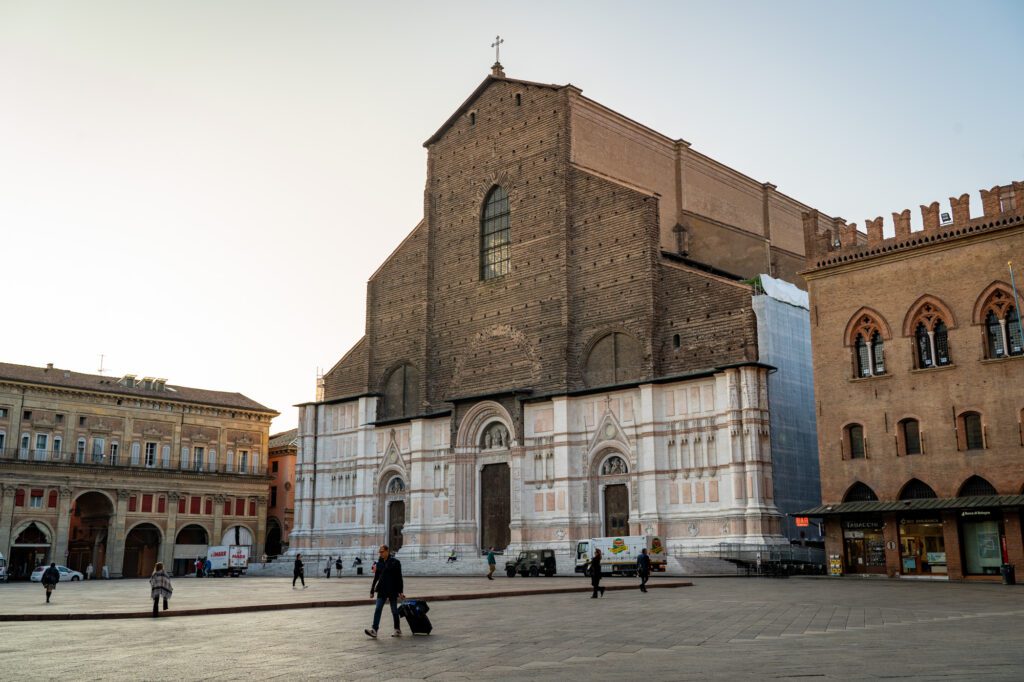
Here are a few of our favorite things to do in Bologna. For more, head over to our guide to spending a day in Bologna.
Climb the Asinelli Tower for Excellent Views. We have friends that live in Bologna, and when we visited them on our first ever visit to Bologna, this was the first thing they did with us. It’s a big climb, but you’ll eventually end up on the top of the taller of the Due Torre (“the two towers”), where you’ll have a commanding view out over Bologna. Book here in advance for a timeslot.
Eat your heart out. Mortadella and filled pastas like tortelloni come from Bologna, but the broader region is home to just about every delicious food we associate with Italy. Parmesan, balsamic vinegar, prosciutto di Parma, lambrusco, and ragu alla bolognese. Go to any of the places in Quadrilatero, which is right off of Piazza Maggiore, to taste and shop. Specifically, we like Tamburini for tagliere (a plate of meats and cheeses) and a glass of wine (lambrusco!), Cremeria la Vecchia Stalla for excellent ice cream (which is NOT the same as gelato), and Vineria Favalli for their excellent Italian wine list.
Take a food tour with a local guide. While you can absolutely get a sense for Bologna’s food offerings on your own, a food tour is going to be the best way to dive a little deeper. This food tour in Bologna was on our list, but after learning they couldn’t accommodate gluten free diets (which, by the way, makes total sense), we decided to skip it.
Take in Piazza Maggiore and Basilica di San Petronio. Piazza Maggiure is the beating heart of Bologna, and one of Italy’s best piazzas in our opinion (as we noted above, Siena’s Piazza del Campo is a close second). There are events nearly every afternoon and evening, from rallies to concerts, and even when there isn’t an official event, you’ll find some of Bologna’s best musicians out on the square (along with a crowd of admirers). The church is worth going into, but it’s only half finished after they tried to make it outshine the Vatican, who said “you can’t do that.” That’s why part of the church’s facade is exposed brick, which is the unfinished portion, while the other part is covered in marble.
Make the climb to Santuario Madonna di San Luca. Bologna is known for porticoes, which are essentially just covered walkways, and you can walk through the 666 (someone has a sense of humor) to get up to this church on the hill. For what it’s worth, this the #1 recommendation from our friends that live in Bologna.
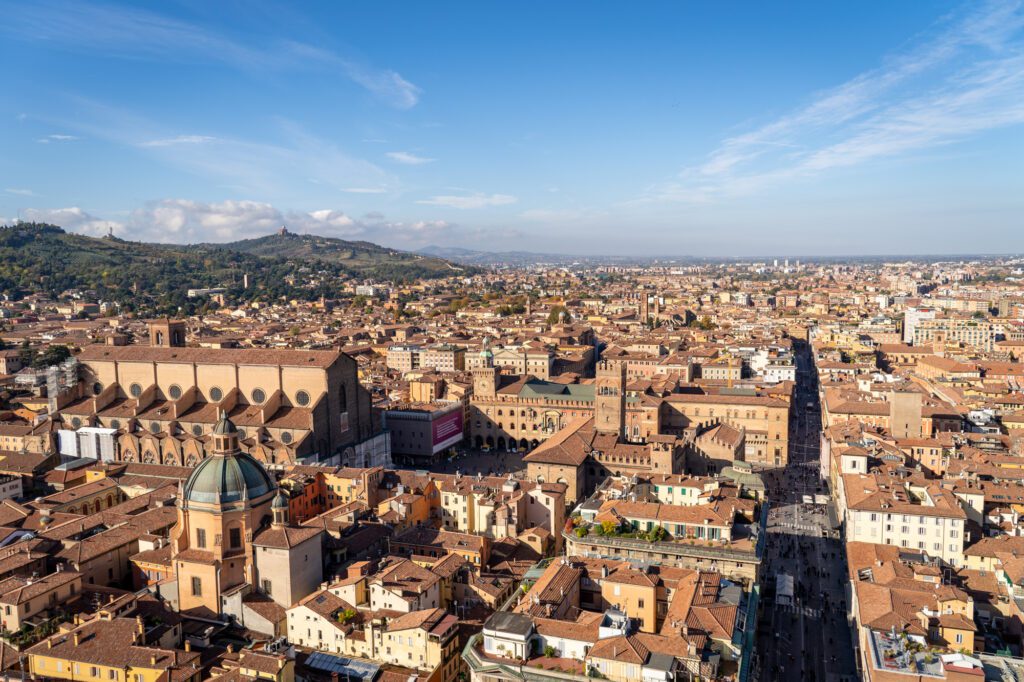
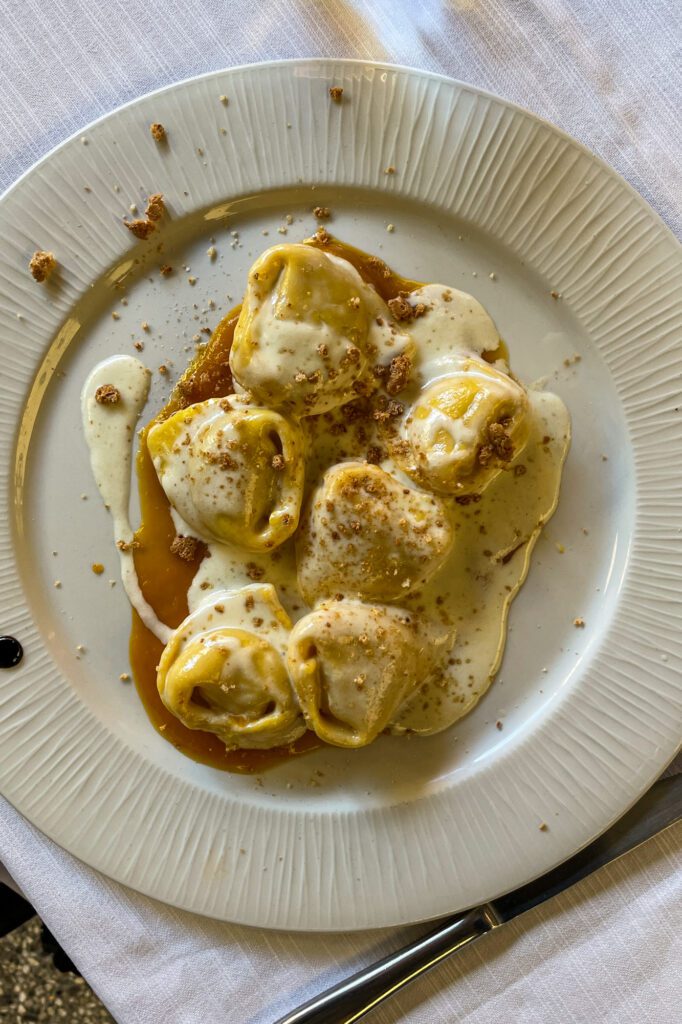
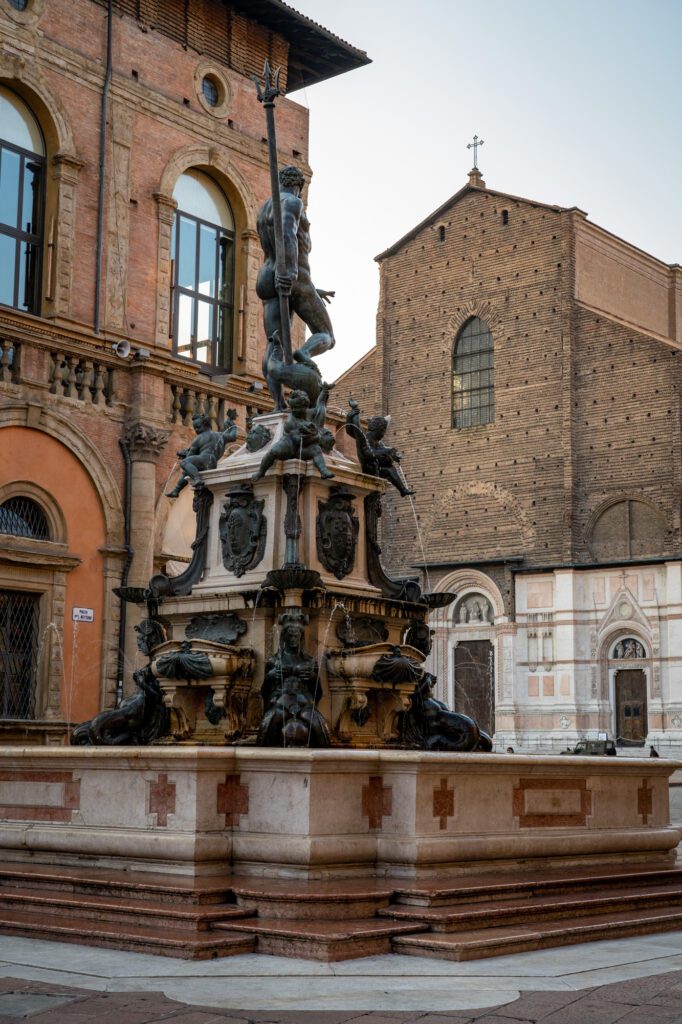
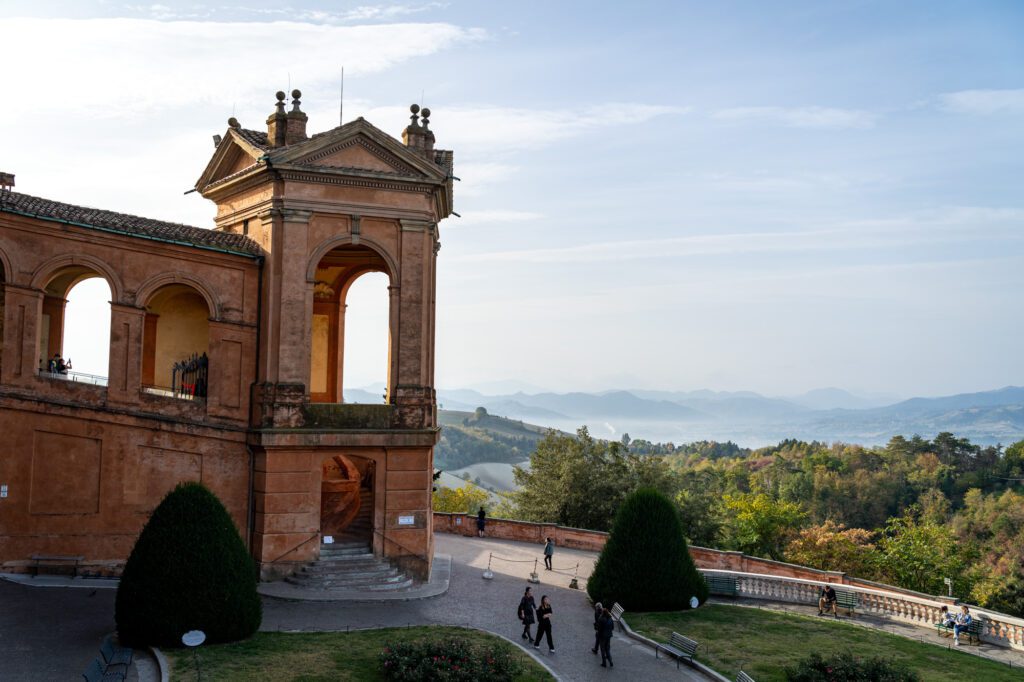
Where to Stay in Bologna
There’s no doubt in our minds – you should stay near Piazza Maggiore while you’re in Bologna. It’s the beating heart of the city, and it’s going to be both the most convenient and the coolest place to stay.
I spent a few days in Bologna solo on my last trip to Italy, and stayed at Bibliò Rooms and Guesthouse. It’s essentially a small B&B that takes up one floor on a residential building about five minutes from Piazza Maggiore.
The rooms are fairly spacious with comfortable beds and private bathrooms, and it’s a good home base for a few nights in Bologna.
I also stayed at the Social Hub in Bologna, which is a hip, young-feeling hotel in Bolognina up near Bologna Centrale.
While the location is further away from Bologna’s main attractions, it is a gorgeous hotel with all sorts of great amenities (a pool, a nice gym, a bar, an events calendar, and ping pong, to name a few). Plus, it’s about five minutes on foot from the train station, so it’s convenient in that sense.
If you’re looking for an apartment, look at Canonica Suites, which is where I kind of wish we had stayed.
We have an entire guide dedicated to helping you figure out where to stay in Bologna with FAR more detail, if you want more of an in-depth look at your options.
Day Trip to Verona: Day 10
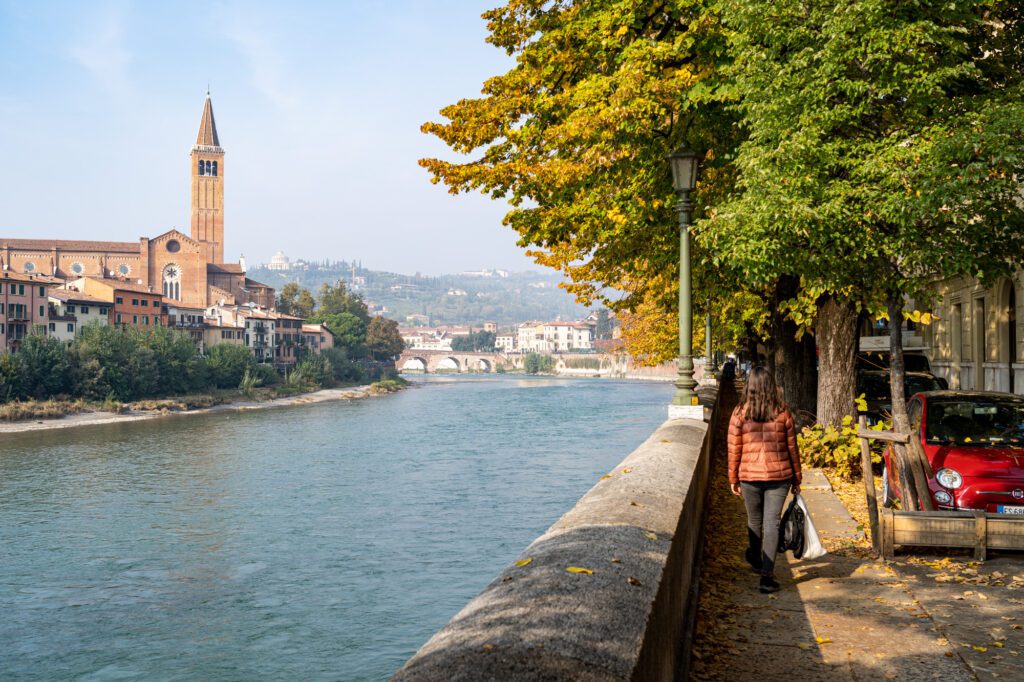
On this day, we’d highly recommend leaving your stuff in Bologna and doing a day trip up to Verona, heading back to spend the night in Bologna.
Verona is famous for being the setting for Romeo and Juliet, but it tied with Bologna for our favorite discovery in Italy when we spent six weeks exploring Italy in 2021.
You might be wondering why we’d do it this way, considering Verona is sort of on the way to Venice (the next stop in this itinerary).
The reason is that we don’t want you to have to worry about juggling your bags, and instead focus on getting an early train from Bologna without the worry of check in times and baggage storage.
Take the high speed train, which takes about 45 minutes or so (book in advance for cheaper tickets!).
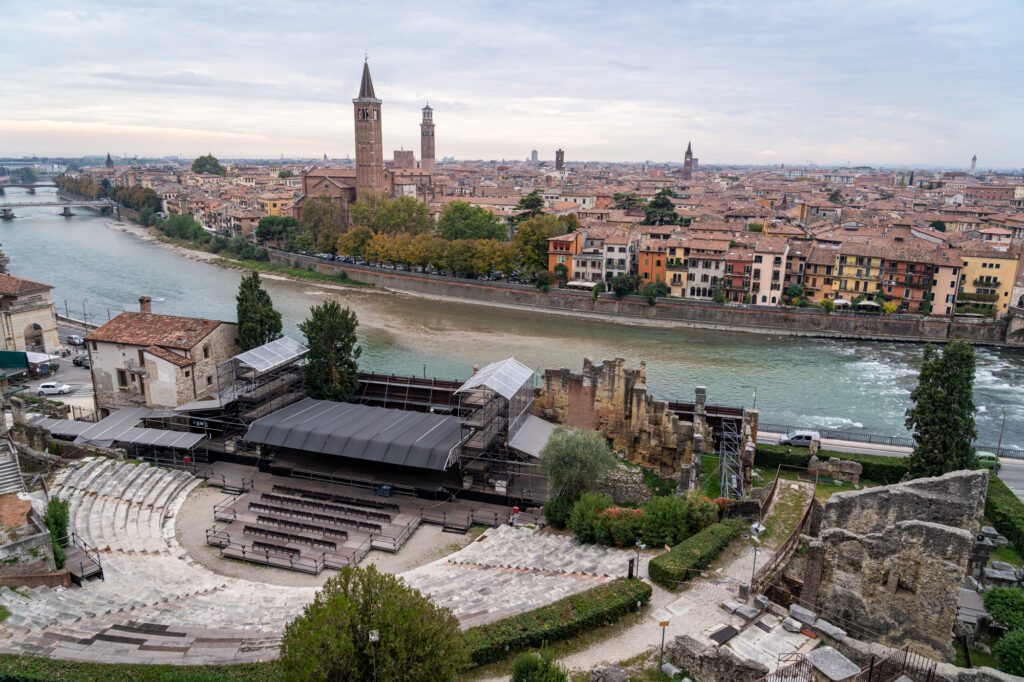
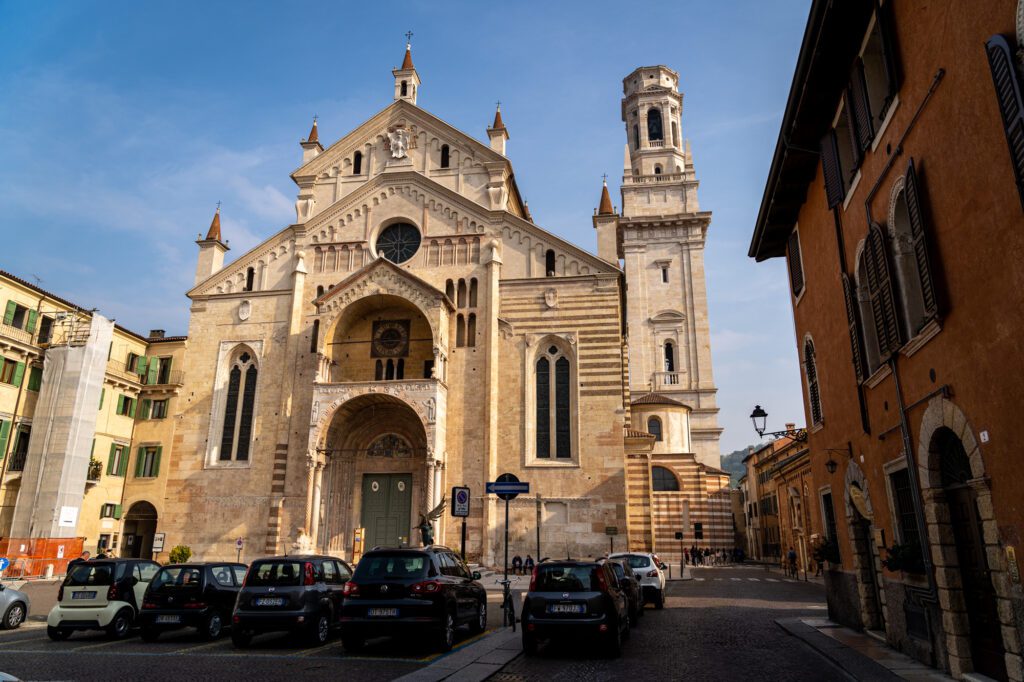
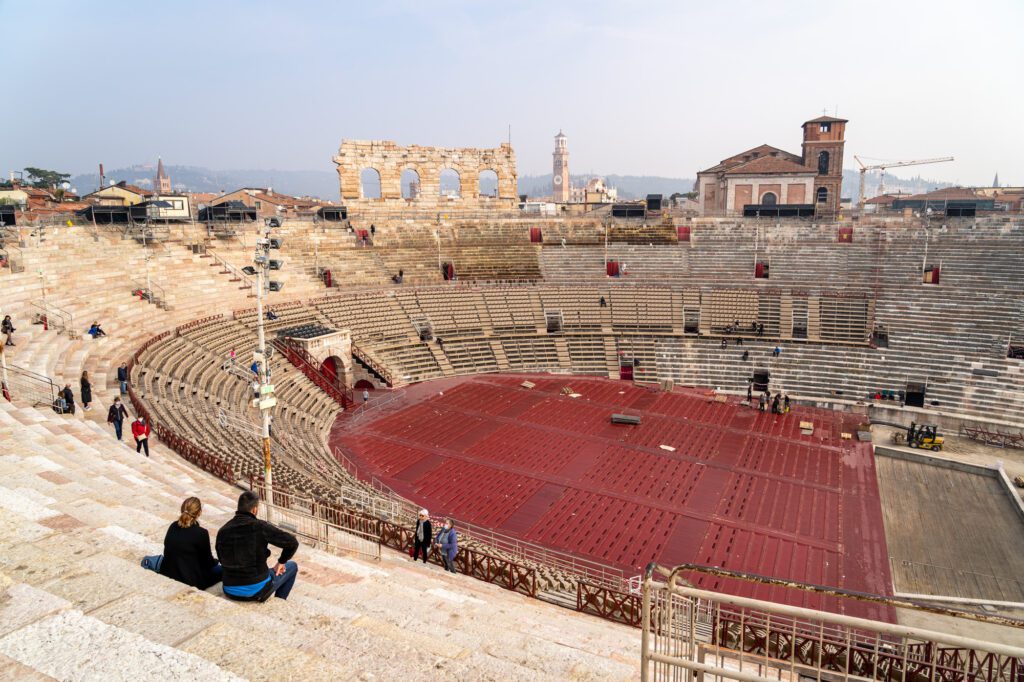
Rather than go into the details of what to do and see with a day trip up to Verona, we’re going to direct you to a separate blog post where we go through exactly that. Here’s how we’d spend a day in Verona.
Venice: Days 11-14
Venice is a place that we have mixed feelings about. We’ve both been to Venice, and as we’ve thought about it, we’re truly not sure if we need to go again.
It’s true that Venice is the best-preserved example of a canal city in Italy, but it’s also true that it’s a beautiful disaster.
There are way, way too many people trying to see Venice for the infrastructure to handle, and cruise ships are a big part of the issue, with huge tour groups coming in for part of a day and contributing very little to the local economy while stressing Venice’s infrastructure.
Remember in 2020 when the canals were all of a sudden empty and pristine, and the swans came back to Venice? It’s safe to say that’s over now.
However, it’s not really fair to say that you shouldn’t get to see Venice because too many people go there.
Instead, we’d recommend that you do go to Venice, but be deliberate about how you do it.
Spend multiple days there so you’re not stressed about the crowds and whether or not you’ll be able to do everything. Eat at local restaurants, and stay in Venice so that your money stays in the local economy.
The best way to explore Venice is not to spend a day (or less) seeing the main sights and calling it a day.
Venice is at its best in the early morning and evening, when it’s notably less crowded. If you only spend a day in Venice, you’re likely going to miss out on that precious time spent exploring during those hours.
That’s why we’d strongly recommend two and a half days in Venice, which gives you a couple of mornings and nights to really soak up the atmosphere of Venice when it’s not packed wall-to-wall with people.
What to Do in Venice
There are a few main sights in Venice that you shouldn’t miss, and two days is more than enough time to see them. Like we said above, part of the fun of exploring Venice is wandering the canals in the early morning and evening.
Piazza San Marco is the main piazza in Venice, and there are a couple of main sights right on the square.
First is the Doge’s Palace, which is a big Gothic building (you know because of the pointed arches) on the lagoon. Over its long history, it served as a fort, a prison, and a residence for the most powerful person in Venice, the Doge.
The version you see today was built in the 1100’s, and has been renovated a few times since as the needs of its inhabitants changed.
It housed the Doge of Venice (sort of like a Duke, but not quite the same) during the Republic of Venice, which lasted for more than 1,000 years starting in the 8th Century and was one of the most powerful city-states in modern day Italy for long stretches because of its position on the water.
The best part about the Doge’s Palace is that it’s an excellent place to learn about Venice’s history. For example, I had no idea that there was a Republic of Venice, let alone how powerful they were.
You can buy your tickets in advance here.
The second major attraction on San Marco Square is the church, St. Mark’s Basilica (Basilica di San Marco), which is the biggest church in Venice.
In a surprising (to no one) twist, the church is attached to the Doge’s Palace, showing the relationship between secular and religious power in Venice over the centuries. It’s set on the site of two older churches, which is a story that you hear over and over again at some of Italy’s biggest and most important churches.
Also similar to other churches in Italy, it was built over such a long stretch of time that it’s one big mish mash of architectural styles and art periods.
It’s an impressive building from the outside, and the interior is special because of the mosaics that cover just about every surface. The Pala d’Oro, which is essentially a big golden altarpiece from the Byzantines, is also pretty cool.
Information on tickets and opening hours here.
If you want to see both with a guided tour, we’d (again) recommend doing the St. Mark’s and Doge’s Palace tour with Take Walks, who we’ve done multiple tours with in multiple Italian cities, and love. It’s three hours long, includes both the church and the palace, and will take you a level deeper than just visiting by yourself.
The islands to the north of Venice – namely Burano and Murano – are well worth a visit, and the vast majority of visitors don’t make it out there.
These tiny islands are known for glassblowing, and they’re relatively easy to reach via water taxi from Venice. From this ferry terminal, it’s a quick 20 minute ride over to Murano, the closer of the two islands (it’s a significantly longer boat ride out to Burano).
You can read more about what to do in Venice in our guide to spending 2 days in Venice.
What to Do with More Time in Italy
If you’re blessed with more than 14 days in Italy, we have (lots of) thoughts on what to do with extra time. Whether it’s one or two days or a full extra week, we have ideas for you based on our own explorations.
Keep in mind that this isn’t an exhaustive list – we haven’t been everywhere in Italy, and it’s hard to recommend something we haven’t experienced ourselves.
For example, the Dolomites and Lake Como are on our list, but we didn’t include them below. Once we make it there, we’ll definitely add them!
You’ll notice that there’s one very popular destination missing from this list that you might be expecting to see: Naples, Pompeii, and the Amalfi Coast.
We contemplated adding it because we know it’s a place that people have seen pictures of and want to visit, but we really wouldn’t do it ourselves due to insane crowds and associated overtourism.
Just this last summer, we’ve seen about 30 pictures of friends on Instagram who all went to the Amalfi Coast within the same two month period.
Which, when you take a second to think about it, is pretty crazy.
We think there are better coastal destinations in Italy (like the Cinque Terre – which has its own over tourism issues – and Sicily) that we’d recommend way before the Amalfi Coast. You’ll find both of those on the list below.
Add Another Day Trip from Bologna
The first thing we’d add if you only have an extra day or two is an extra night in Bologna to explore more of Emilia-Romagna.
Cities like Parma (famous for prosciutto and parmesan-reggiano) and Modena (famous for balsamic vinegar) are an easy train ride away, and are well worth your time.
We’d highly recommend a day trip that starts with Claudio’s tour of a working parmesan-reggiano dairy, which of course includes a tasting of different ages of parmesan, and a vacuum packed chunk to bring home with you.
It was the highlight of our last trip, and Claudio is friendly, uber-charismatic, and an all around phenomenal host.
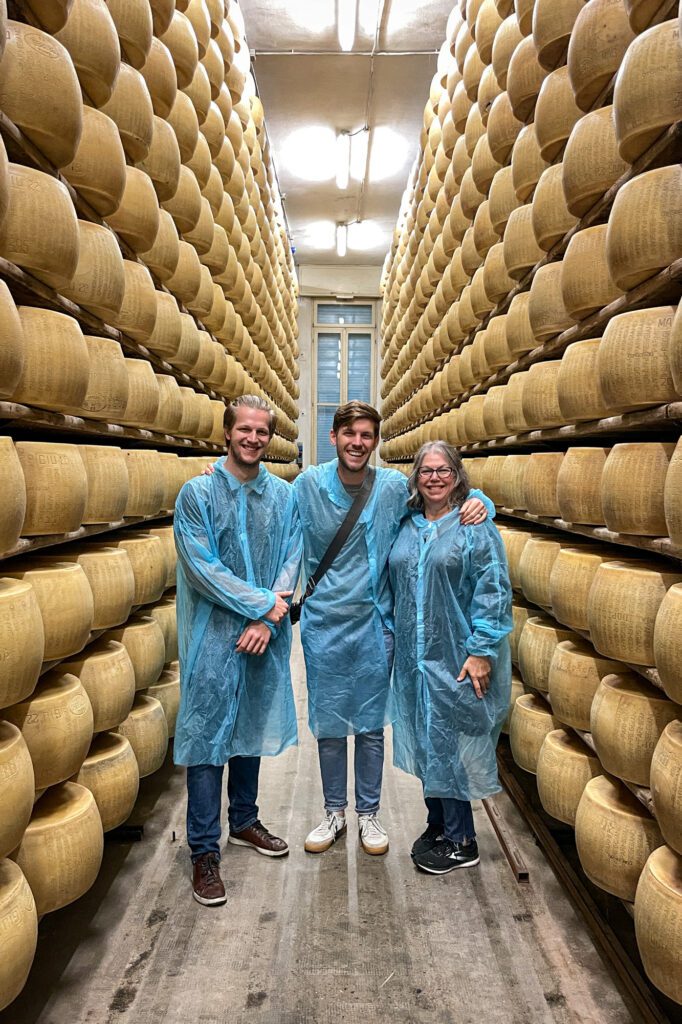
That tour is a morning tour, going until roughly noon.
We’d then spend the rest of the day in Modena, which is the capital of balsamic vinegar production and is an easy 20 minute ride from the train station in Reggio-Emilia (where you’ll get dropped off by Claudio). That’s what we did.
We loved tasting small production balsamic vinegar at La Consorteria 1966 (you should know that the tasting costs money unless you buy a bottle afterwards, which are expensive because this is the good stuff).
We also had multiple people recommend Osteria Francescana, which is a world-famous fine dining experience that you’ll need to book well in advance.
You can also try chef Massimo’s food at nearby Franceschetta58, which is less expensive and more approachable (you still want a reservation, though!).
Another great stop is the Mercato Storico Albinelli, which is Modena’s central market.
Add Another Day Trip from Florence
The second thing we’d add is an additional day trip from Florence. We gave you three options above, and if you took our advice, you’ve already done one of them. Do a second (or third!) one if you have an extra day.
Cinque Terre (2-3 Days)
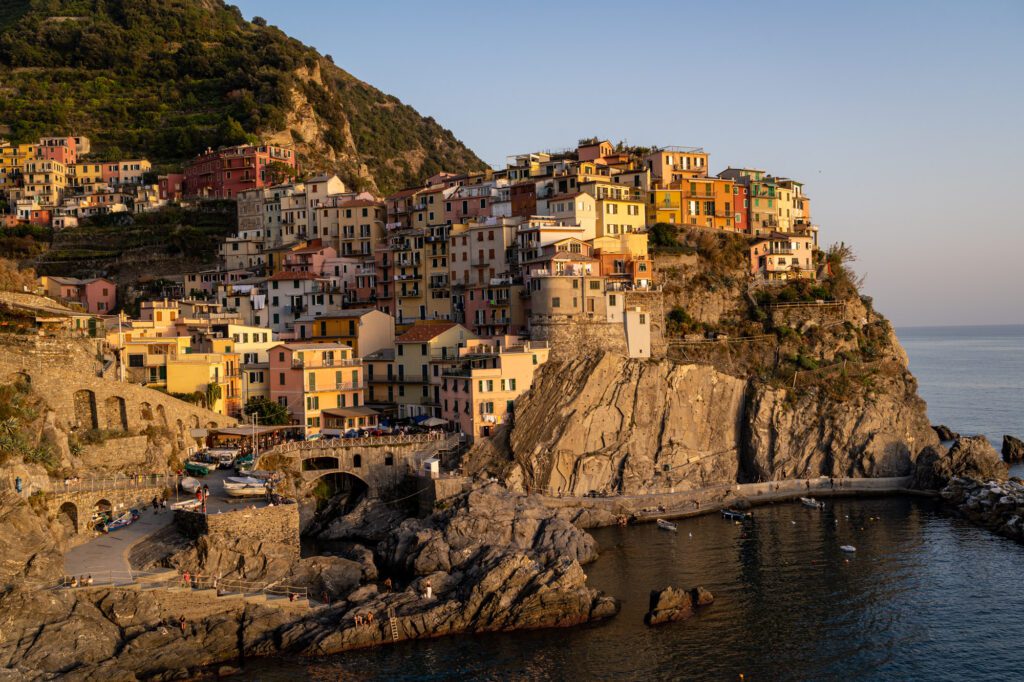
For my mom’s 60th birthday, we took her on a two week Italy trip. Her two must-do experiences were the Cinque Terre and seeing the Last Supper in Milan.
So, we spent a few days exploring the Cinque Terre, and we loved it.
However, we have a major caveat. We would absolutely NOT recommend a day trip to the Cinque Terre, which is what approximately 90% of people seemed to be doing.
The main reason is that it’s a long way from places like Florence and Milan, requiring three hours of travel time.
That means you won’t arrive until mid-morning, which is when all of the other day trippers arrive, and the streets and trails are packed wall-to-wall. It’s no wonder people say it’s too crowded!
The magic of the Cinque Terre is in the early morning and late evening, when the day trippers clear out and it becomes a tranquil, slow paced coastal retreat. That means you’ll need at least one night (two or more is better).
The Cinque Terre, which literally means “Five Towns,” is a series of charming towns tucked between the mountains and the coast in northern Italy.
It’s known for hiking, terraced vineyards, and colorful towns perched on rocky outcroppings above the sea.
You’ll definitely want to hike a section of the Blue Trail (we like the one from Corniglia to Vernazza the most), dive into the wines of Cinque Terre, take in some excellent sunset views, and explore all five towns.
We have a bunch of guides dedicated to helping you plan your Cinque Terre trip. Here are some links for you:
Milan (2 Days)
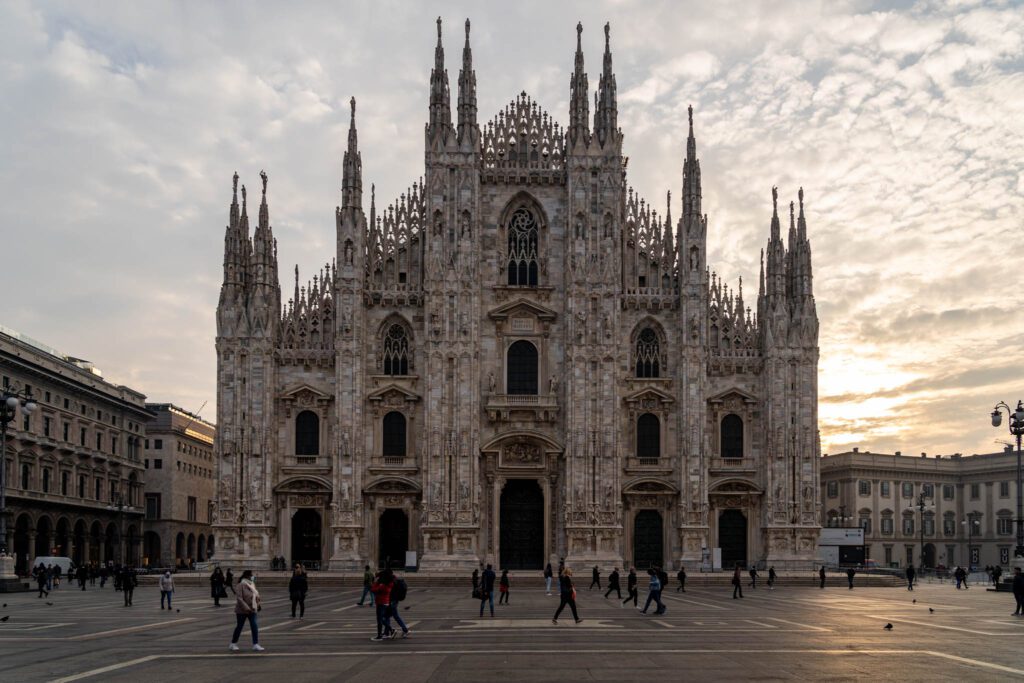
Milan is a really great city that offers something a little different from other major cities like Rome and Florence.
That’s not to say that it’s not a historic city, but it feels less “Italian” than Rome and Florence mostly because it has been trading hands between the Spanish, French, Italians, and Austrians for centuries.
There is a difference that you’ll notice right off the bat, probably when you exit the train station.
It looks and feels more modern, which is mostly a function of the fact that it’s a major financial hub and home to just about every high end fashion company in the country.
There are two world-class attractions in Milan – the Duomo di Milano which took 600 years to complete and is a mishmash of different styles that somehow still works, and Da Vinci’s Last Supper.
However, it’s worth lingering for an extra day to explore some of Milan’s less famous attractions and the hip food and drink scene.
Wander Parco Sempione and pop into Castelo Sforza, and experience aperitivo in the Navigli District, which is home to some of Milan’s last exposed canals (it used to look like Venice!).
Where to add it: You could either do Milan after Bologna (there’s a high speed train connecting the two), or after Venice (and fly out of Milan).
We have a bunch of guides dedicated to helping you plan a trip to Milan. Here are some links for you:
- One Day in Milan: The Best of Milan in a Day
- 2 Days in Milan: How to Plan An Incredible Milan Itinerary
- Where to Stay in Milan: A Complete Guide
- The Best Things to Do in Milan
- Where to Find the Best Specialty Coffee in Milan
- Gluten Free Milan: A Complete Guide for Celiacs
Sicily (7 Days)
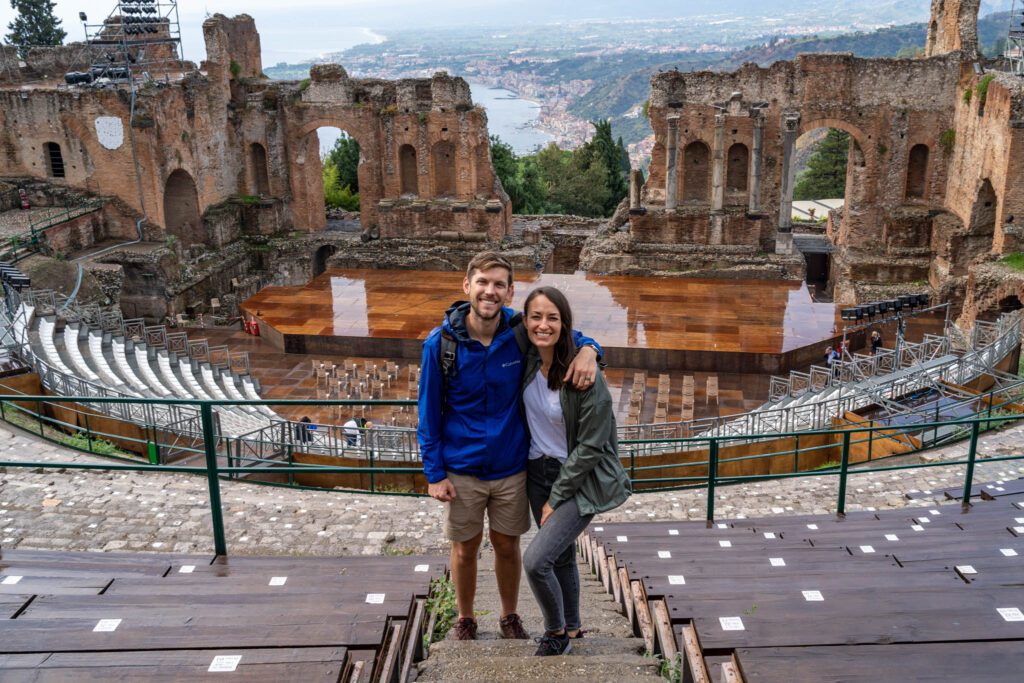
If you have about a full week of extra time, we’d highly recommend exploring Sicily.
We love Sicily (Alysha’s family is from a small town in southeast Sicily), and spent three weeks on the island in the fall (which somehow was still not enough time).
However, you should know that Sicily is massive, and it’s impossible to do the entire island in a week.
For that reason, we’d focus on southeastern Sicily (Catania, Mount Etna, and Syracuse). Unfortunately, that means you’ll miss Palermo, which is an amazing city in northwestern Sicily.
The other reason to focus on southeastern Sicily is that you don’t need to rent a car. The corridor from Taormina to Syracuse is connected by a regional train line, which is something that can’t necessarily be said for the rest of the island.
To get there, you’ll need to fly. The best place to fly into is Catania (Catania–Fontanarossa Airport).
Definitely don’t miss a day trip from Catania up to Mount Etna, which was among the highlights of our trip (you can read about it in our guide to the best things to do in Catania) and a trip to the amphitheater in Taormina, which has a spectacular view.
Oh, and eat all of the pistachio and almond granitas you can.
We have an entire guide dedicated to helping you plan a Sicily itinerary, which has a couple of ideas for how to spend 7 days on the island (P.S. we recently wrote a specific guide for spending 7 days in Sicily, which is even more helpful and specific in this context).
Where to add it: We’d add it after Venice, flying from Venice to Catania (which might require a connection) and flying home from Catania.
What to Do with Less Time in Italy
We’re not going to dive deep into how to spend less time in Italy, mostly because we’ve already done exactly that in some of our other guides.
We have a guide to 10 days in Italy that’s geared towards first-timers that focuses on Rome, Florence, and Venice, and how to make the most out of your time in those places.
We also have a guide to spending 7 days in Italy, which is a little different because it gives a bunch of different ways to do a weeklong trip to Italy.
If you’re looking for ideas for a shorter trip, definitely read those.
When to Visit Italy
Having spent some time in Italy over two consecutive fall seasons, I’m here to tell you that it’s absolutely my favorite time to be in Italy.
Summer is oppressive for two reasons. One, it’s sweltering. My first ever visit to Italy was late July in Rome, and it was miserable. Two, it’s simultaneously crowded and empty. Crowded with tourists, empty of locals (who all go on vacation in August). Not a great combination. It’s also very expensive, relatively speaking.
Fall is more moderate in both respects. By the end of fall – late October and November – it gets a little chilly, especially further north. But, all in all, September and October are an incredibly pleasant time to be in Italy.
Winter is going to be cooler and grayer, but significantly cheaper. The other thing to watch out for is things – bars, restaurants, shops, tours – closing, especially in smaller, more tourist-centric places like the Cinque Terre and beach towns in Sicily.
Spring is just a hair behind fall in terms of the best time to be in Italy, and anytime between Easter and the end of May would also be an excellent balance of weather and crowds.
